
SUPPORT PUP IN TRAINING Meet Burney! He's spreading smiles on his journey to being a therapy dog. 28 BUZZING WITH PRIDE Students shine at the annual Region 10 Spanish Spelling Bee. 20 A CUT ABOVE A district leader is drumming up business for their school's cosmetology program. 51
Our story began with a teacher. Our founder spent his days teaching and his evenings studying law. Today, his legacy of leadership and excellence guides our public education section as they provide counsel to school districts, district personnel, public and private schools, and colleges.
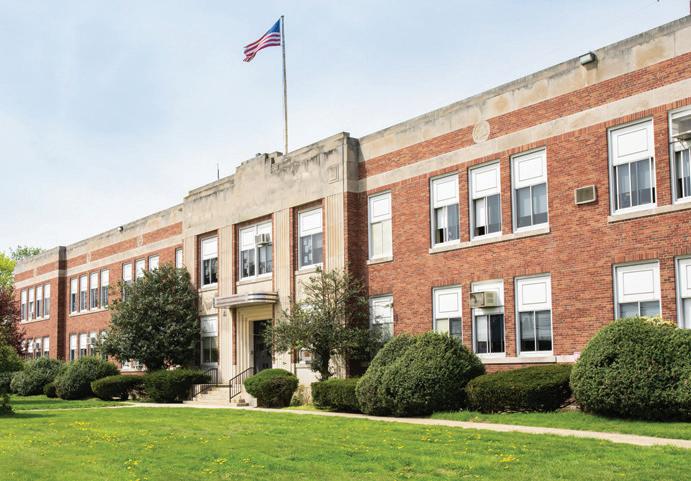




We’re proud to support educators.

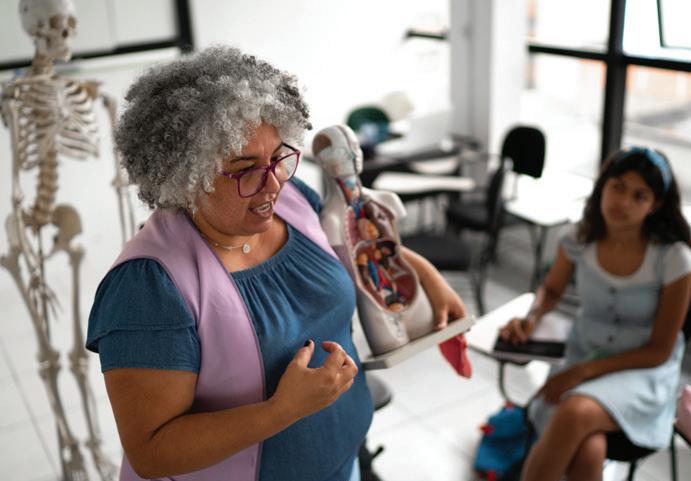










AMARILLO • FORT WORTH • LUBBOCK • PAMPA

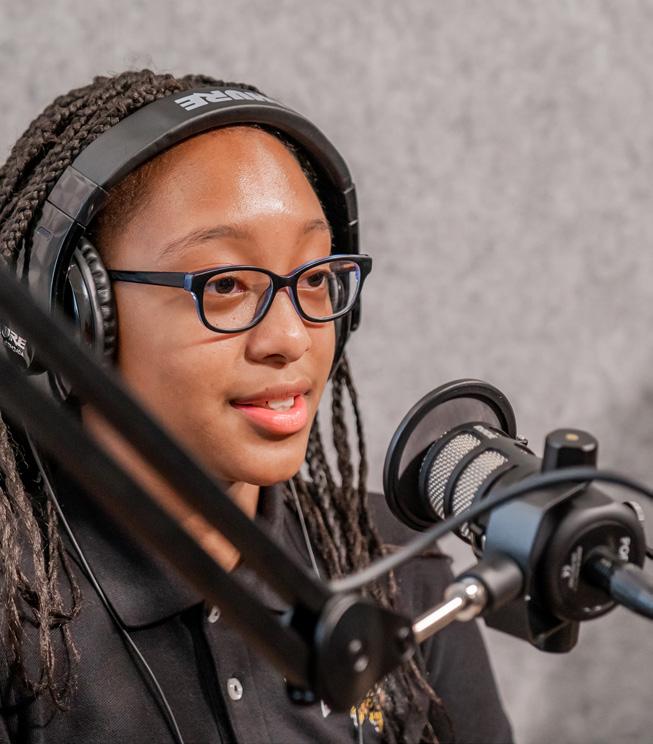
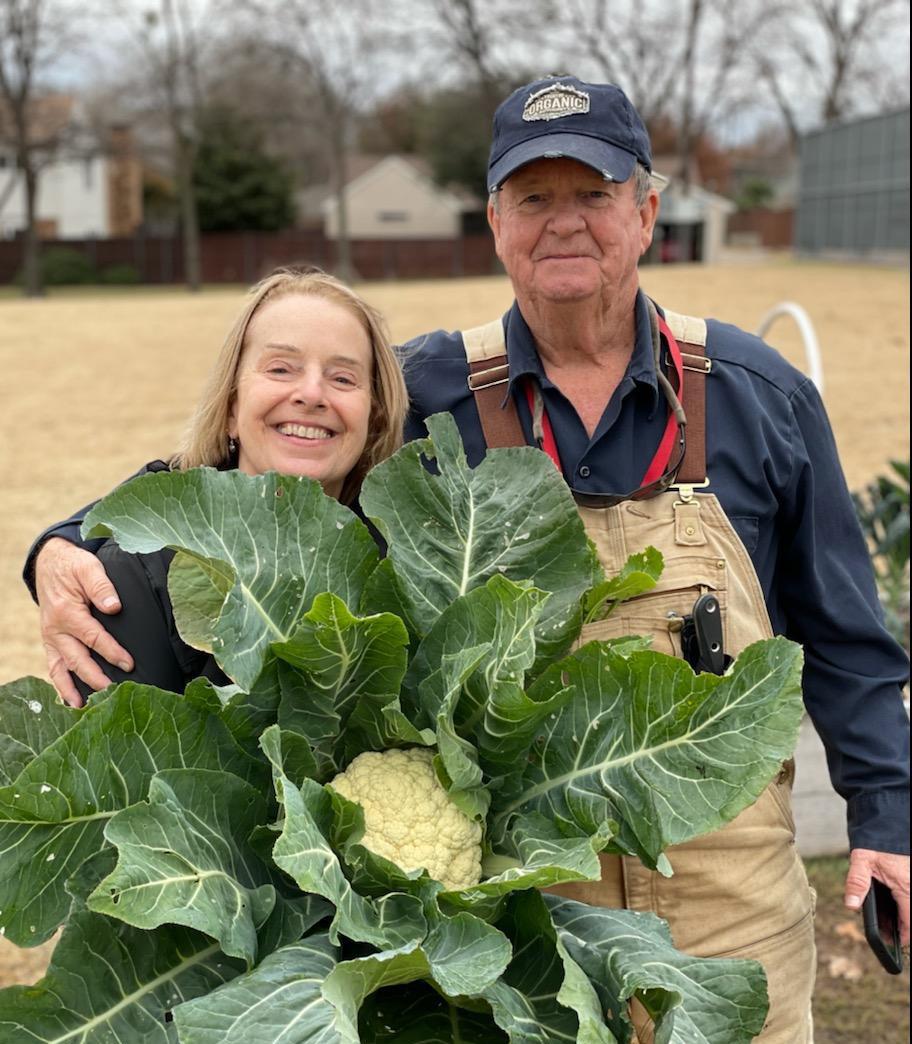




Reach! magazine is published twice annually by Region 10 Education Service Center, whose mission is to be a trusted, student-focused partner that serves the learning community through responsive, innovative educational solutions. For information about advertising or to suggest a story idea, please contact Rachel Frost, Chief Communications Officer, at rachel.frost@region10.org. To learn about the programs and services of Region 10, visit www.region10.org The Importance of Knowing History 3 Growing Curiosity 4 Learning "In a Cup" 9 Learn, Grow, Succeed 12 From Parent to Teacher 17 Buzzing with Pride 20 Partnering for Friendship 24 Region 10 Points of Pride 26 Support Pup in Training 28 Listening and Learning 33 Supporting School Nurses 36 Data Discoveries 38 The Teacher Pipeline 42 A Certifiably Rewarding Experience 45 International Leadership Podcast - Now on Air! 48 A Cut Above 51 Taking Teaching Skills to the Next Level 52 CONNECT WITH REGION 10 @Region10ESC 4 28 48 1
SPRING 2022
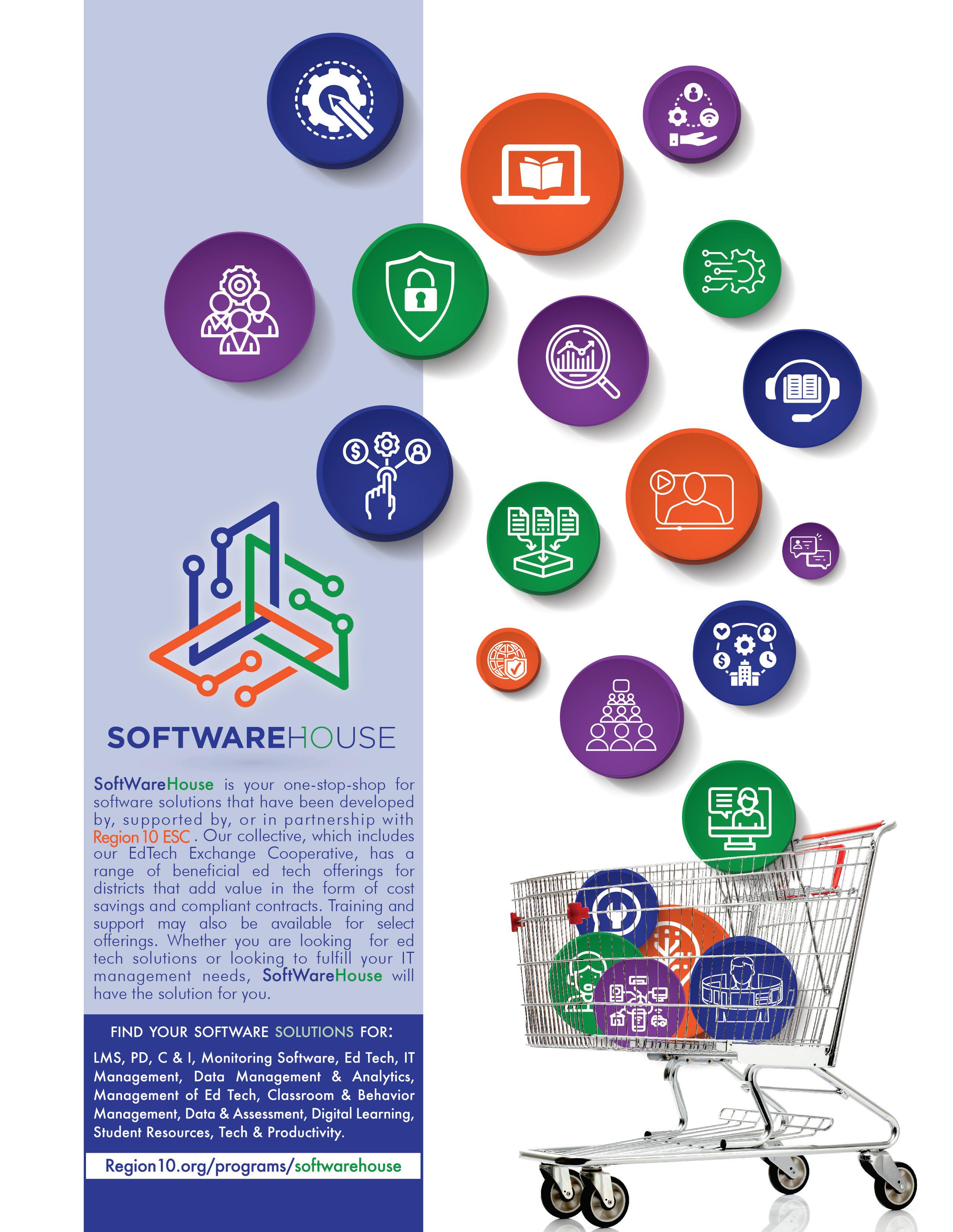
The Importance of Knowing History
AUTHOR: DR. GORDON TAYLOR Region 10 Executive Director
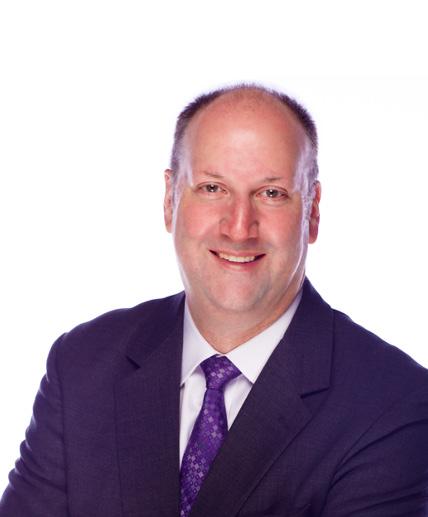
Knowing history is beneficial; and really thoughtful adults will stand in line to attest to the benefits of knowing and understanding the past.
I applaud the discussion that the State Board of Education (SBOE) had at its last meeting about a total rework of the Social Studies TEKS. Instead of students experiencing the current puzzle pieces of World, United States, and Texas History, the SBOE discussion seems to herald a move to a model that threads history together. This will allow students to understand how today’s events are influenced, caused, and linked to events and decisions in the past – in context with local, national, and worldwide events. The SBOE also seems to be on a track that will tie Geography, Economics, and Government/ Politics into the historical context rather than being addressed separately and independent of historical context.
As a former History and Social Studies teacher, I reflect on how much better I could have communicated and helped students understand history if the state had provided TEKS (or Essential Elements) framed as is currently being discussed. All of my former students would have a better understanding of:
• How Texas oil/gas industry regulation was the model for OPEC, which coupled with the
geography of the Middle East, affects the economy of Russia.
• How the history of European land wars, since the time of Napoleon, have been about the need for agricultural land, development of industry, and control of access to seaports and worldwide markets, which allows countries to diversify the economy and build the wealth of particular people with common cultural heritages.
• How the two previous bullet points led to aggression by Russia against Ukraine, and how that follows the same pattern of World War I starting when the Austro-Hungarians attacked Serbia and of World War II starting when Germany attacked Poland.
I think we will be better at educating students to become the next generation of Texas, US, and world leaders with the changes that the SBOE is considering, because knowing history is beneficial.
3

4
Photos: Coppell ISD
Growing Curiosity
AUTHORS: RACHEL FROST, Region 10 Chief Communications Officer
AMANDA SIMPSON, Coppell ISD Director of Communications
LARRY THOMPSON understood the importance of being willing to pivot long before the days of COVID. After spending more than 35 years in the semiconductor industry, Thompson turned his life-long gardening hobby into a full-time job. As the Garden Coordinator for the Coppell ISD Child Nutrition School Gardens, Thompson understands that the harvest is at the mercy of the weather, the school calendar, busy educator schedules, and not to mention, lots of little hands that are learning what it takes to grow fresh produce. That means making adjustments along the way is all part of the process.
Thompson says it takes “rigid flexibility” to manage 16 active gardens across the district,
which are funded through a $45,000 grant from the Texas Department of Agriculture (TDA). Right now, they’re in full spring mode.
“Transplants and direct sow seeds are coming alive in the gardens. Students planted onions in January and potatoes in February, and those are starting to take over the garden space,” Thompson explained. “Other cold crops like kale, Swiss chard, cabbage and lettuce will be ready to harvest in April. Things are looking pretty tasty!”
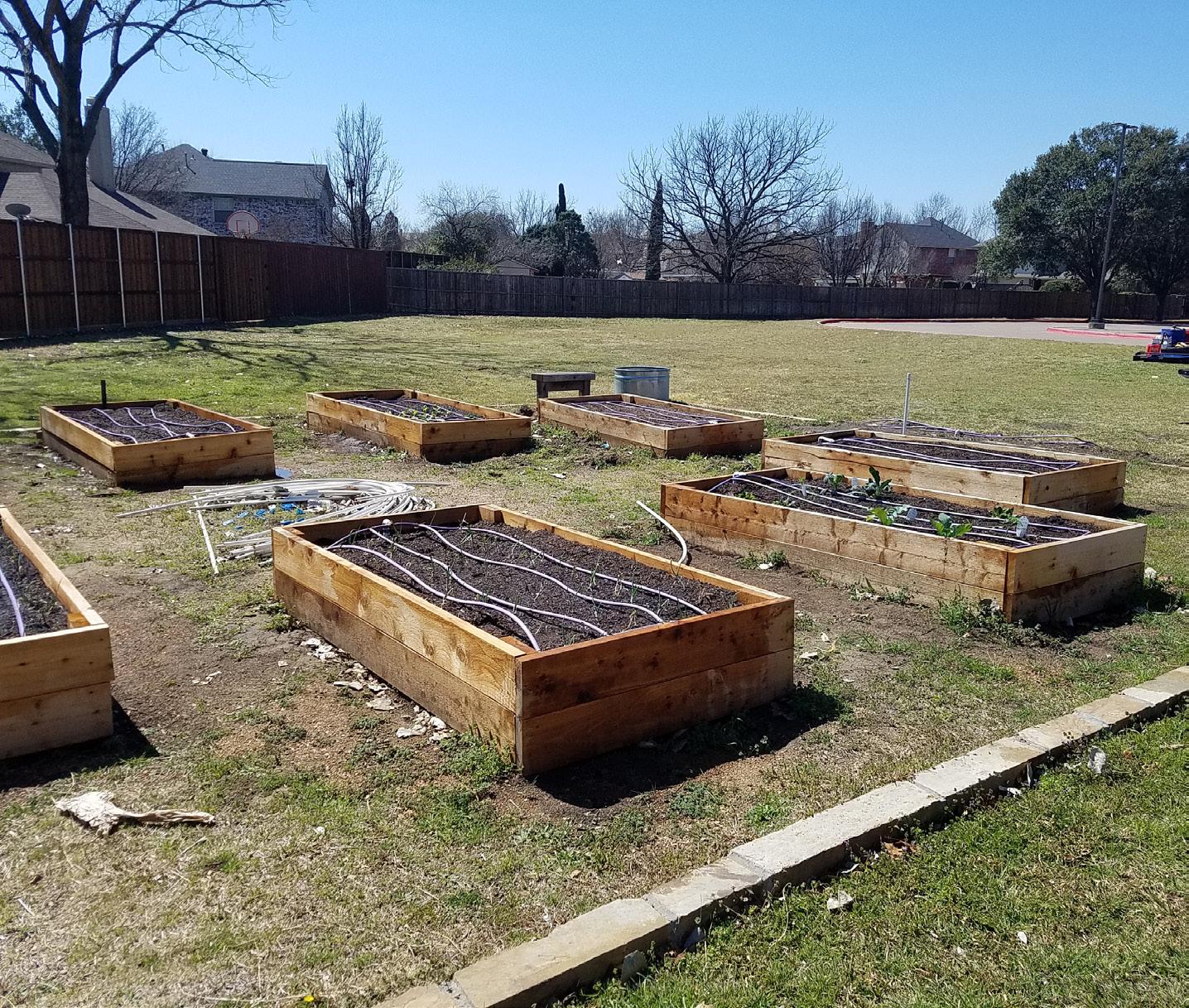
At the end of May, when students harvest the onions and potatoes, some of the vegetables will go back to the school cafeterias for “Farm Fresh Fridays.” Thompson works with the cafeteria chefs to come up with recipes that


5
incorporate the fresh produce into the meals that students are served in the cafeterias. Any excess is used in the Free and Reduced Lunch program or donated to the Metrocrest Services Food Pantry, which serves the CISD community.
“For some students, this will be their first time to try these different vegetables,” Thompson said. “It’s the little things, like watching the elementary students harvest vegetables like carrots, that make this work so rewarding. They are always amazed by what is underneath the soil surface.”
Thompson works closely with students, teachers, and parent volunteers to maintain the gardens. This is the third year CISD Child Nutrition has received the TDA Expanding 3Es School Garden Grant, which funds enhancements to the school gardens through the purchase of equipment, seeds, educational materials, and more. The goal of the grant is to help CISD students connect with the "3E's of Healthy Living — Education, Exercise and Eating Right."
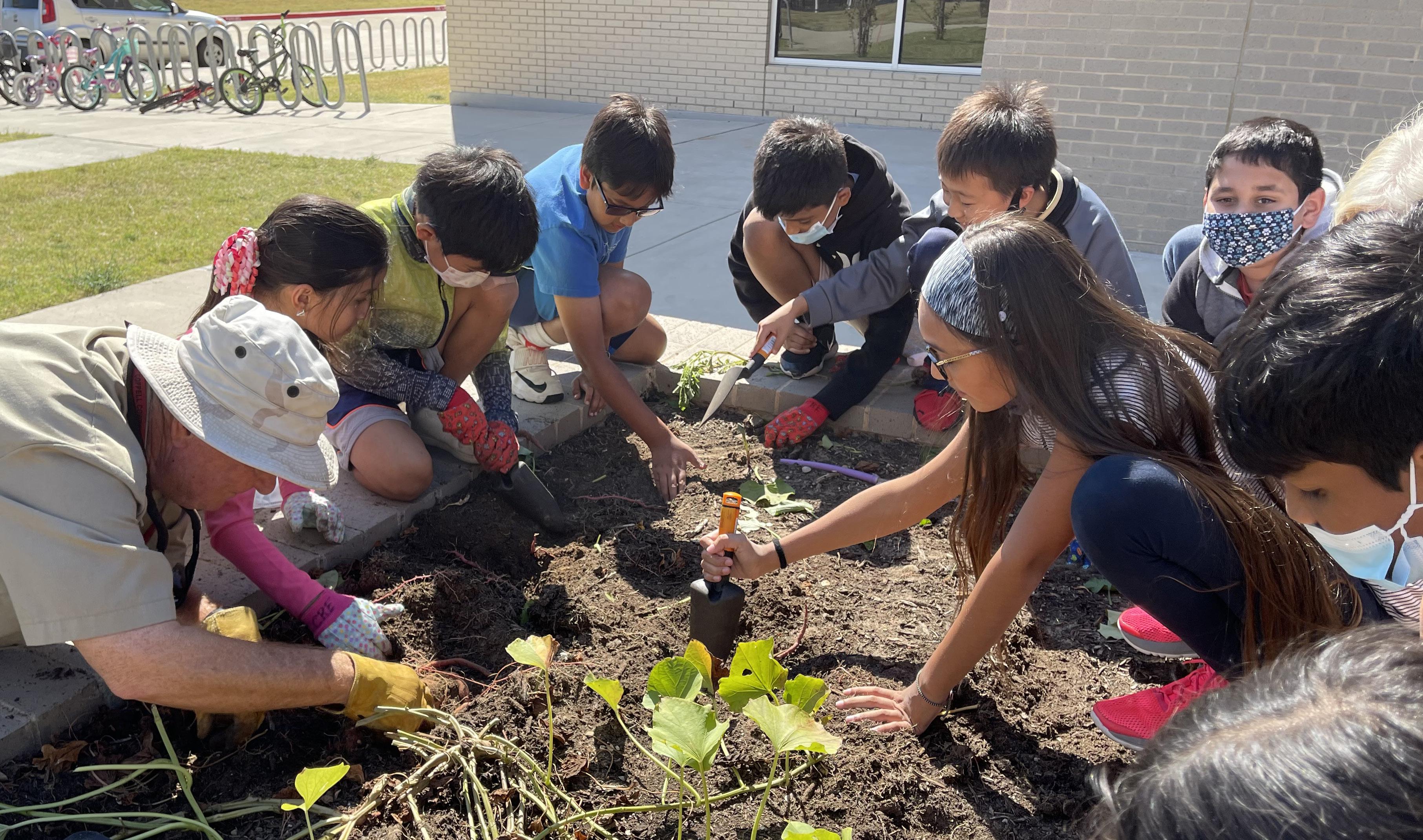
“My ultimate goal is to teach and mentor students and teachers in the garden,” Thompson shared. “Getting to teach them things, like
planting an onion (green side up!) is really rewarding. I also love getting to meet and work with our teachers - they are an amazing group!”
Thompson takes pride in his work and is continually learning and challenging his own gardening skills. However, Thompson explains that it doesn’t take a huge budget or decades of gardening experience to start a school gardening program.
“Start small,” Thompson explained. “Keep it simple and start with one bed where you can plant a little something and then expand as time and money permit. If a vegetable garden is too time consuming, plant a flower garden or a pollinator garden - something to get students learning outside in the fresh air - that’s what’s really important.”

6
To learn more about the CISD Child Nutrition School Gardens, scan the QR code.
Isyourschool accurately assessingyour students?
EmmaRinge - SchoolsDirector,WhizzEducation
WhizzEducationcollaborateswithschools acrosstheUSAtoidentifyspecificlearning
•AnEducationSuccessPartnerdedicated toyourschooltodeterminethebest formatofthetutoringsessions
•Data-driveninstructionembeddedinthe schoolday
•Astandardlearningmetricthat benchmarkseverystudentinyourschool
Real-TimeAssessment and reportingonchildren’s progressacrossthewhole school,aresomeofthemost significantchallengesfacing schoolsanddistrictstoday.Itcancome atasubstantialcostyetoftendoesnot providetheinformationneededtogain theinsightstomakerobustdecisions.
•Thesamereportingqualityacrossevery class
Asalong-standingeducationpartner accountableforlearningoutcomes,Whizz Educationcansupportyouandyour schoolthroughaconsultativeprocess thattakesintoaccounttheuniquecontext ofyourschool,torecoverlostlearning experiencedbyyourstudentsduringthe pandemic,rapidly.
ARE and increasing the Math Age for example, by working in collaboration with schools to understand the context, any challenges and behaviors, and then we develop a course correction to improve performance.
Whatiftherewasaneducation consultancywhocouldprovideyou with:
•Real-time,continuousformative assessment
•Real-time,continuousformative assessment
•Thesamereportingqualityacrossevery class
•Astandardlearningmetricthat benchmarkseverystudentinyourschool
•Data-driveninstructionembeddedinthe schoolday
R•AnEducationSuccessPartnerdedicated toyourschooltodeterminethebest formatofthetutoringsessions
eal-TimeAssessment and reportingonchildren’s progressacrossthewhole school,aresomeofthemost significantchallengesfacing schoolsanddistrictstoday.Itcancome atasubstantialcostyetoftendoesnot providetheinformationneededtogain theinsightstomakerobustdecisions. Whatiftherewasaneducation consultancywhocouldprovideyou with:
WhizzEducationcollaborateswithschools acrosstheUSAtoidentifyspecificlearning objectivesanddevelopstrategic implementationplanswhichencompass; highimpactmathtutoring,continuous formativeassessmentandcourse correction,drivenbycombiningquantitative learningdatawithanunderstandingofour partners'localcontext.Anaddedbenefitto WhizzEducationisourabilityto supportSpecialEducationalstudentsforin schoolandathomelearning.Whizzcan removebarrierstopromoteequityand inclusiontoensurethateverystudentcan achieveinmath!
10 ESC Cooperative Contracts
Whizz Education now joins the organizations approved for Region
Whizz Education now joins the organizations approved for Region 10 ESC Cooperative Contracts. It offers affordable access to board acceptable, EDGAR compliant solutions.
Becoming a preferred supplier means the process is streamlined for those schools looking to Whizz Education as an avenue of support in relation to the urgent call to action of House Bill 4545 to provide 30 hours of individual tutoring for students at risk of failing STAAR.
Asalong-standingeducationpartner accountableforlearningoutcomes,Whizz Educationcansupportyouandyour schoolthroughaconsultativeprocess thattakesintoaccounttheuniquecontext ofyourschool,torecoverlostlearning experiencedbyyourstudentsduringthe pandemic,rapidly.
It offers affordable access to board acceptable, EDGAR compliant solutions. Becoming a preferred supplier means the process is streamlined for those schools looking to Whizz Education as an avenue of support in relation to the urgent call to action of House Bill 4545 to provide 30 hours of individual tutoring for students at risk of failing STAAR. Michelle Turner, District Engagement Consultant with Region ARE example, schools challenges develop performance. Data can also be used to compare students’ progress with performance in a school’s chosen third party assessment. Whizz Education collaborates with schools across the US to identify specific learning objectives and develop strategic implementation plans. By working together, we can make a significant contribution to recovery through data driven, continuous assessment programs designed to spot learning gaps and enabling teachers to give targeted support without additional burden.
EmmaRinge - SchoolsDirector,WhizzEducation

Michelle Turner, District Engagement Consultant with Region 10 Data Solutions, is thrilled to partner with Whizz Education through our EdTech Cooperative.
Isyourschool accurately assessingyour students?

WhizzEducationusesanalyticsgenerated bythevirtualtutorMath-Whizz, synthesizedwithqualitativefeedbackand reflectionsfromourEducationSuccess Partnerstoenabletheimplementation plantoberefinedsostudentsand teachersrealisethefullbenefitsof individualizedtutoring.Wereferbackto theobjectivesofimproving
Data can also be used to compare students’ progress with performance in a school’s chosen third party assessment. Whizz Education collaborates with schools across the US to identify specific learning objectives and develop strategic implementation plans. By working together, we can make a significant contribution to recovery through data driven, continuous assessment programs designed to spot learning gaps and enabling teachers to give targeted support without additional burden.
AdvertisementFeature
EmmaRinge SchoolDirector WhizzEducation
AdvertisementFeature www.whizz.com/en-us/ info@whizz.com







302 W. BROAD STREET, MANSFIELD, TX 76063 - PH:682.422.0009
Learning “In a Cup”
AUTHOR: RACHEL FROST Region 10 Chief Communications Officer

“Are we going to do science on paper or in a cup?”
In 32 years of teaching, that’s one student's question that has stuck with Randi Kerby throughout her career.

“At first I didn’t understand what he meant, but then I realized, he wants an experience,” Kerby explained. “It was the most brilliant way I’ve ever heard that said. So I always think, ‘What can I do to make this experience in a cup?’”
Kerby, who teaches fifth grade Science and Social Studies at Billie Stevenson Elementary in Rockwall ISD, strives to create “in a cup” experiences for her students as often as possible. One of those experiences she looks forward to every year is taking her students to an outdoor camp. Unfortunately, the district has had to cancel those trips for the past couple of years due to COVID.
In addition to dealing with the day-to-day challenges of COVID, Kerby has also been battling cancer. In September 2020 she was diagnosed with breast cancer. After going
through surgeries, chemo, and radiation, she learned in August 2021 that the cancer had metastasized to her bone. Still, she continues fighting, not only for her own health, but also to bring back those experiences that her students have missed out on the past two years.
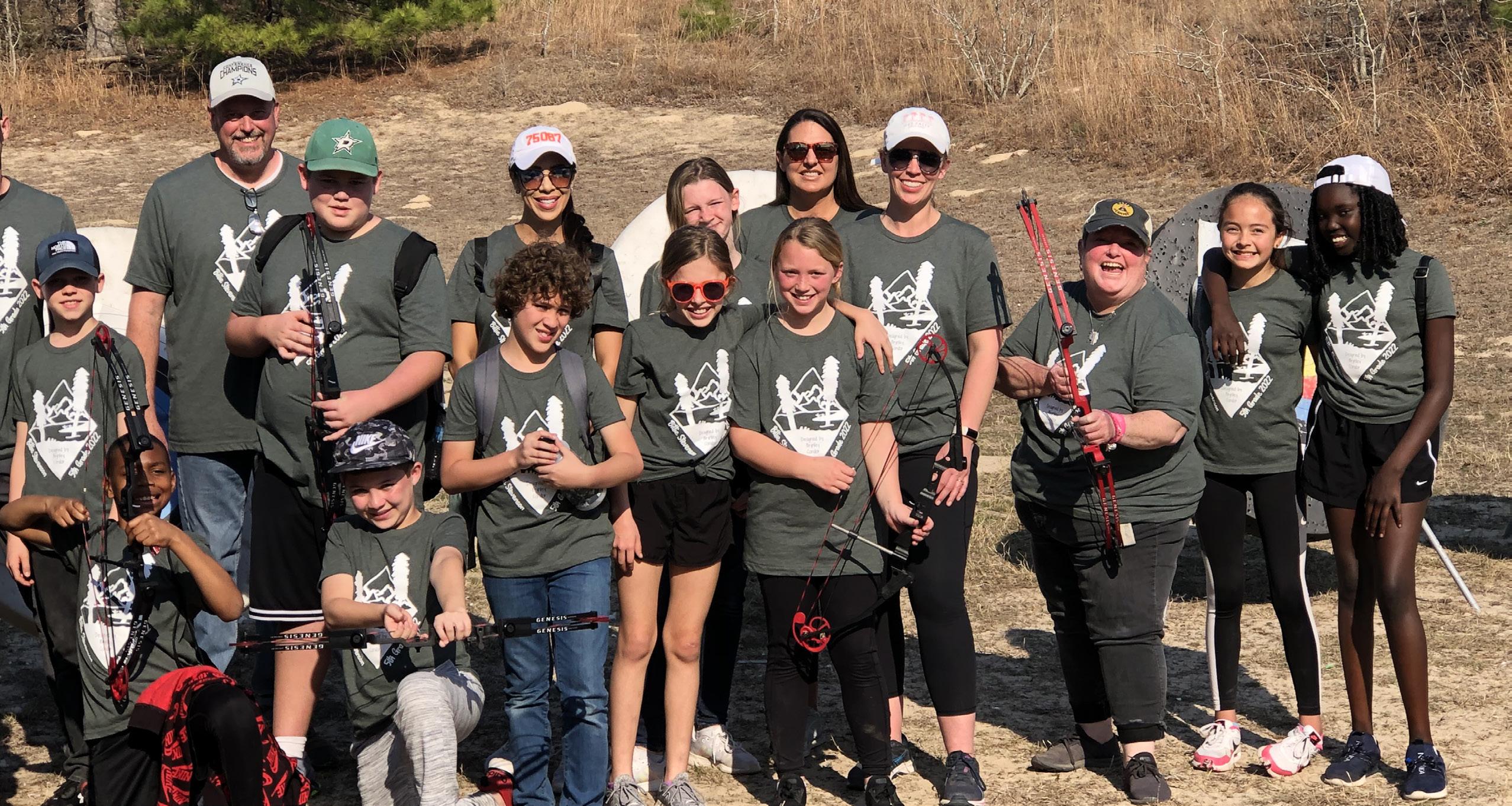
“I feel like the past couple of years have been really hard on all of us. So we were determined to get the students something back that they

9
were always supposed to have,” Kerby shared as she choked back tears. “I knew getting to go to camp was going to be really special for them.”
In March of this year, on what she described as the “perfect day,” Kerby loaded up on the bus with her students and headed to the Trevor Rees-Jones Scout Camp in Athens, Texas to participate in Region 10’s Academic Outdoors program.
Out at the camp, students explored the campgrounds and enjoyed participating in activities like archery, canoeing, s’more making, rappelling, and so much more. Throughout the day, students reflected on their experiences in their journals.
“One of the things I loved was hearing them apply or put into action the things that we had learned in the classroom - they were making those connections,” Kerby shared. “One of the prompts we put in the journal was ‘What is something you learned about yourself?’ It was very revealing to us what this experience meant to them. A lot of them wrote about trying something new that they had never done before. Something I saw over and over was, ‘I don’t give up.’ That’s a huge life lesson, especially through this difficult time.”
For Kerby, seeing her students try something new and difficult while not giving up is what matters most. Katie Braden, Rockwall ISD Elementary Science Coordinator, thinks it’s that can-do attitude that Kerby expects of herself and her students, that makes her such an exceptional educator.

“She pushes herself so hard to be the teacher that she has always been - even through everything she is going through,” Braden explained. “To be able to have that moment at the camp with them was so special, and the students are still talking about it. Now, she’s taking that experience and she’s talking about it with the students, and it just connects and threads through everything.”
It’s those connections between the experiences and the learning, and between Kerby and her
students, that keeps her motivated every day.
“I wish nobody would have cancer, but I wish everybody could feel the love and support that I’ve felt,” Kerby said. “I am so grateful to still be able to be at school where I get the energy and encouragement I need from these kids.”
“Everyday that she can be here, she is here and she is engaged with her kids,” Braden said. “Randi Kerby is a gem. She lights a fire for kids, and she supports other teachers across this district. If you want to see magic, just walk in and watch her teach.”
In the classroom or at a campsite, Kerby creates that magic “in a cup” for her students each and every day.
10

How Can ClassLink Help? In the Classroom or From Home Easy Access to Learning Resources is Essential Today’s education environment demands that schools are prepared for quick shifts between remote , in-person , and blended learning . This can be challenging , but schools don’t have to face this daunting task alone. ClassLink was built for this. Identity Management ClassLink Roster Server and OneSync use automation and open standards to make rostering and provisioning easier, more secure, and less time-consuming Access ClassLink empowers 16 million students and staff with instant access to a library of 6,000+ single sign-on apps from the classroom or at home Usage Analytics ClassLink Analytics provides essential usage data, so instructors can measure engagement and leaders can make informed purchasing and training decisions (862) 225-1518 mkeith@classlink.com Mary Keith www.classlink.com
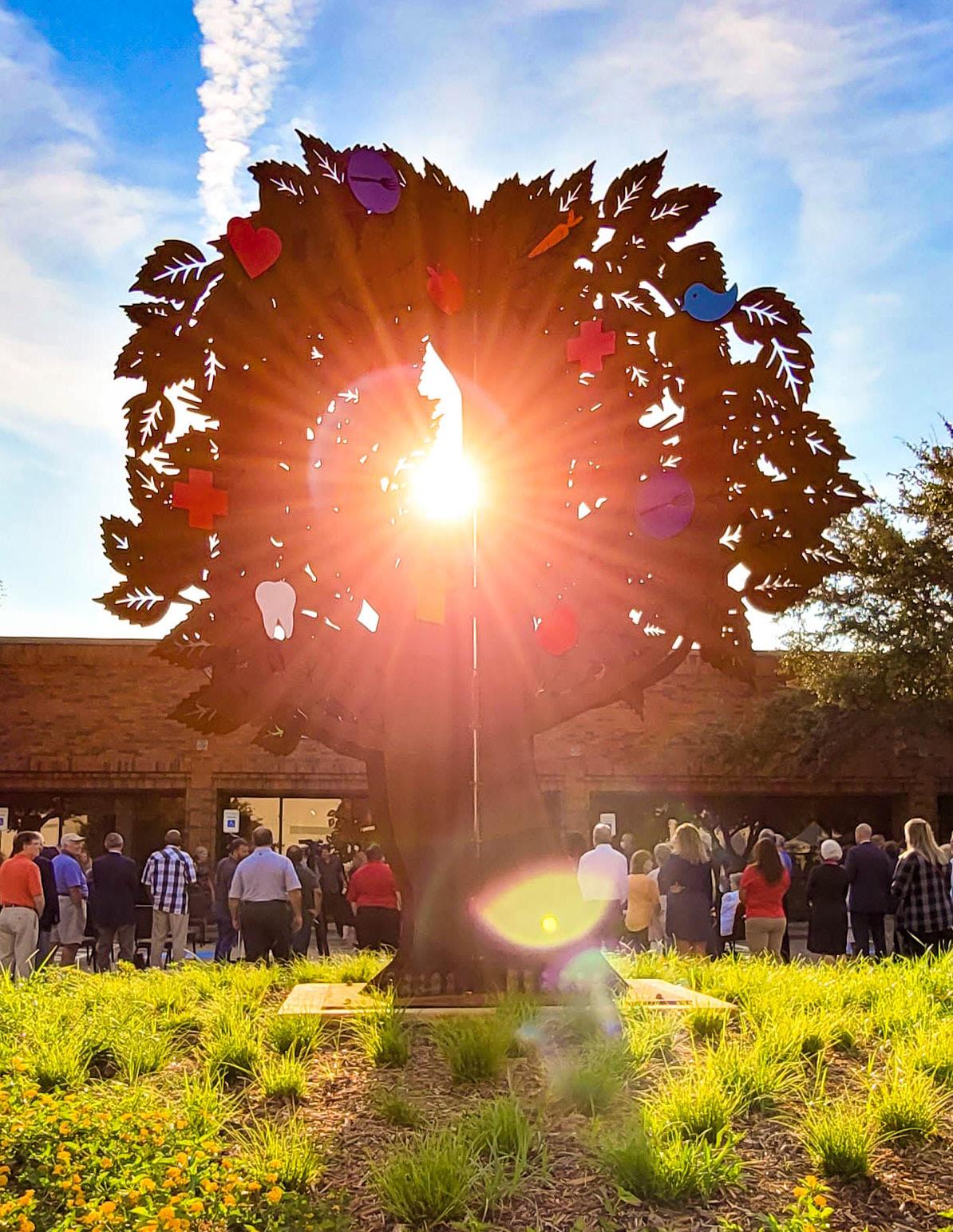
12
Photos: Richardson ISD
Learn, Grow, Succeed
AUTHOR: JASON PHILYAW Richardson ISD Communications Specialist
RICHARDSON ISD is a place where all students connect, learn, grow and succeed. The school district’s strategic plan includes a commitment to ensure all families, businesses, and community partners are fully engaged in that mission.
RISD’s partnership with the Network of Community Ministries has provided invaluable support, not only for students and their families, but also staff members during times of crisis and need.
“Our relationship with the Network continues to bear fruit every day,” RISD Interim Superintendent Tabitha Branum said. “Every day one of our students needs a new pair of shoes or more school supplies, or a family is met with food insecurity, and every day Network steps up and fulfills that need. We are also grateful for all the RISD community members who donate to Network and to those who volunteer at the facility. We are a stronger school district because of this close partnership.”
Throughout the pandemic, Network has supported RISD families by addressing food insecurity issues, clothing needs, school supply shortages, and even financial support during emergencies.
Network CEO Cindy Shafer said the partnership has helped the nonprofit tremendously in reaching additional families in need within the district.
“Through our collaboration in mobile food distribution over the past three years, to RISD's ongoing promotion of family services at Network through their marketing channels, more of our neighbors are learning about and benefitting from our crucial programs,” Shafer said. “It has been a pleasure having such a willing and enthusiastic community partner to walk with us as we work to improve the quality of life of RISD students and their families.”
When the RISD community was hit by a tornado in October 2019, the district immediately leveraged the partnership with Network as part of a larger emergency response effort. The Network helped RISD provide basic needs, including shelter, food, clothing, and relocation services for students and staff who were impacted.
Also that fall, Network launched its mobile food pantry that initially focused on four high-need schools, providing food monthly for qualifying RISD students and their families. During the summer of 2020, as the pandemic exacerbated food insecurity issues for many RISD families, the school district and Network further cemented their partnership by providing thousands of boxes of food each weekend at distribution centers across the district.
Network added a second mobile food pantry in December 2021 and immediately expanded weekly visits to nine RISD schools, reaching more families who are still struggling due to


13
the pandemic and other economic hardships. Network also provides RISD educators with a food pantry service that gives teachers healthy snacks for their classrooms for students in need.
In the fall of 2021, Network moved into a larger facility on International Parkway in Richardson. The complex also includes a new Richardson ISD Family Services Center that houses the district’s newcomer center, Student Services department and guidance and counseling teams.

Families new to RISD and enrolling for the first time now have access to this plethora of services provided by the school district with across-thehall access to everything Network provides, as well. The new facility is truly a one-stop shop for anyone new to the area who needs help registering kids in school, keeping food on the table, and connecting with people who want to help.
“With RISD’s Student Service department being located in Network’s new building, it has truly never been easier for families to have access to Network’s services,” Shafer said. “If a family who could benefit from the Network comes into RISD’s Student Services department, they can immediately be referred to us for help with food, clothing, utility assistance, career services, adult education programs, and more. This convenient access provides a one-stop shop for more
families in need, and those not yet familiar with Network's resources.”
Later in 2022, Network, Methodist Richardson Medical Center and RISD plan to open an RISD Employee Clinic at the new Network facility that will be available for drop-in medical services for a low co-pay fee for the nearly 6,000 RISD staff members and their families.
Network is also a major sponsor of RISD’s annual Back to School Backpack Bash that furnishes students with school supplies, haircuts, and other wellness services ahead of the first day of school.
Founded in 1985, Network began during an economic downturn when several churches and community organizations came together to form an alliance to assist families in need. Today, Network is a non-denominational, communitybased organization serving nearly 30,000 individuals annually through over 142,000 units of service. Network’s service area encompasses the entirety of the 14 zip codes within Richardson ISD.
“We are fortunate and so grateful to have the Network as a critical resource and strategic partner for the families and staff of Richardson ISD,” RISD Interim Superintendent Branum said.
14
Ignite Learning Breakthroughs
Start with SEL
Imagine Purpose Prep, our social and emotional learning (SEL) program, fosters student well-being so that academic success can follow. We empower educators to integrate SEL into the classroom, giving them powerful ways to connect with students.

Adaptable, Engaging Language Development
Designed to supplement core literacy instruction, Imagine Language & Literacy® is the only personalized learning program that accelerates both literacy skills and English language development for students in grades PreK–6.
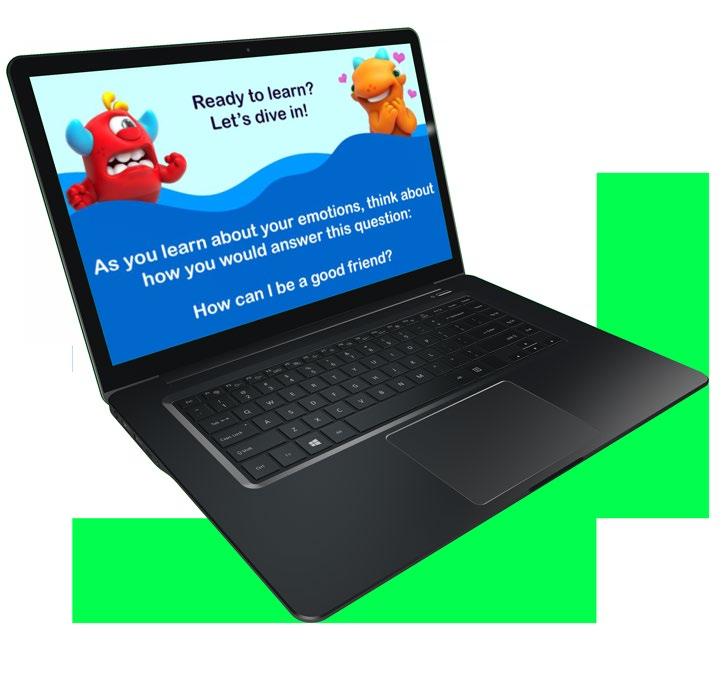
Discover more at ImagineLearning.com
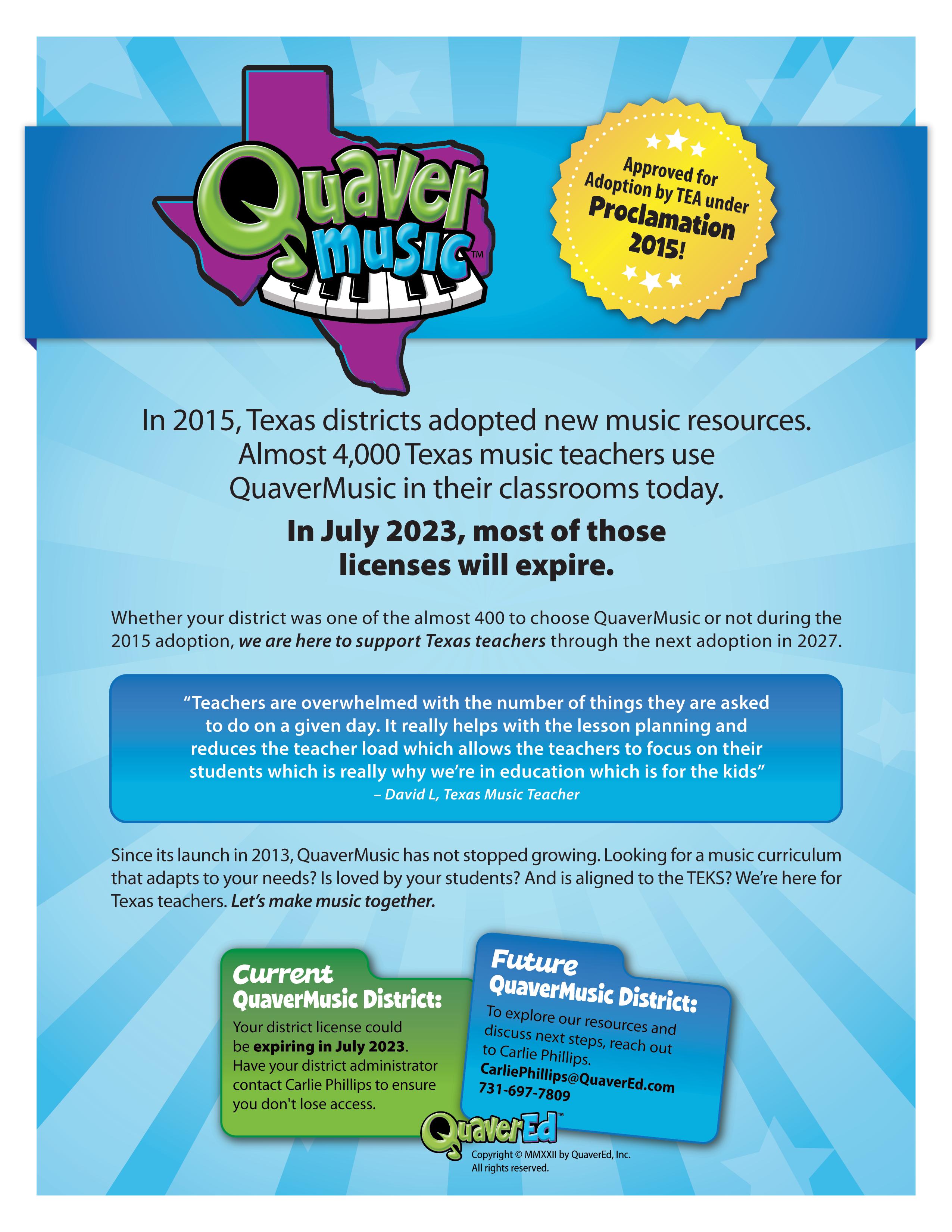
From Parent to Teacher
 AUTHOR: JON SHELDON Region 10 Digital Media Producer
AUTHOR: JON SHELDON Region 10 Digital Media Producer
IT is a little after eight o’clock at Wilson Elementary in Crandall ISD, and Serena Johnson is welcoming her Head Start students into the classroom. As the last student arrives, they all sit down to enjoy breakfast in the classroom - family style. They talk about the previous day, what cartoons they were watching, and what makes an insect an insect. After breakfast, it’s carpet time and Johnson leads her students in song before she goes over what’s in store for the day.

Johnson’s classroom is divided into little learning nooks where students can master the lesson of the day, insects. There’s a tent with vines hanging above it where students can use flashlights, learn about insects, and read to each other. In another section of the room
there’s an ABC station that challenges students to learn how to spell and write out the names of insects. One corner is dedicated to a science and math station with real, preserved insects where students can look at them up close with a magnifying glass and count the number of legs. There’s even a little sand box where students use fine motor skills to solve problems. Her classroom is anything but boring - it is designed and intentional - learning through play.
Johnson has a unique understanding of the importance of creating an exciting environment where the littlest of learners will thrive. She began her journey in the Head Start program as a Head Start parent 16 years ago when her family needed additional support.
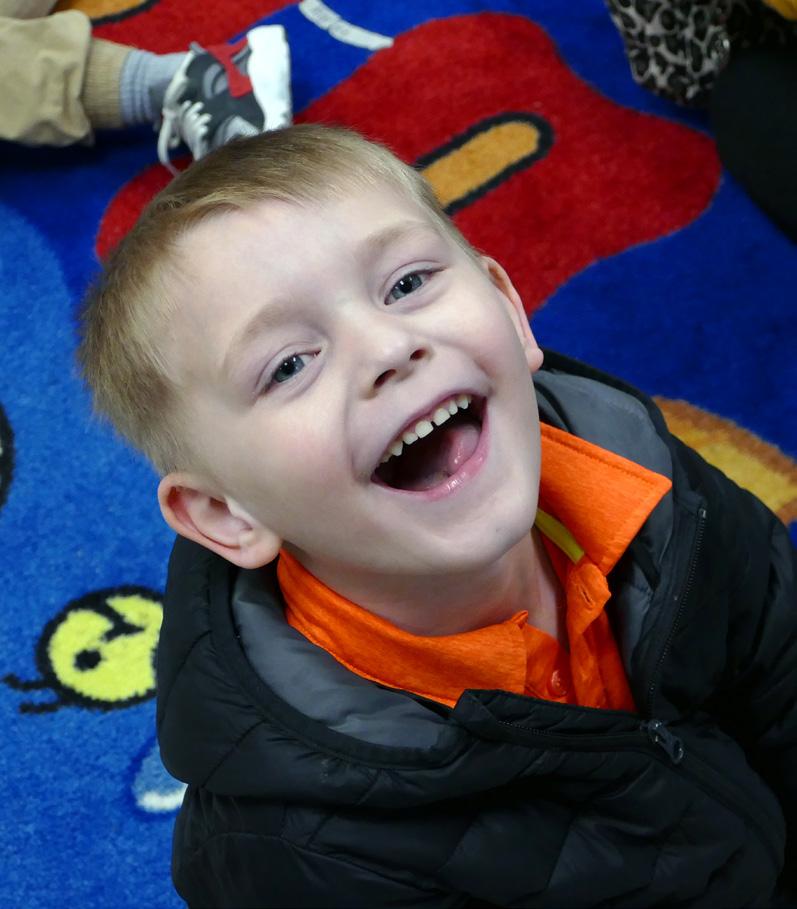
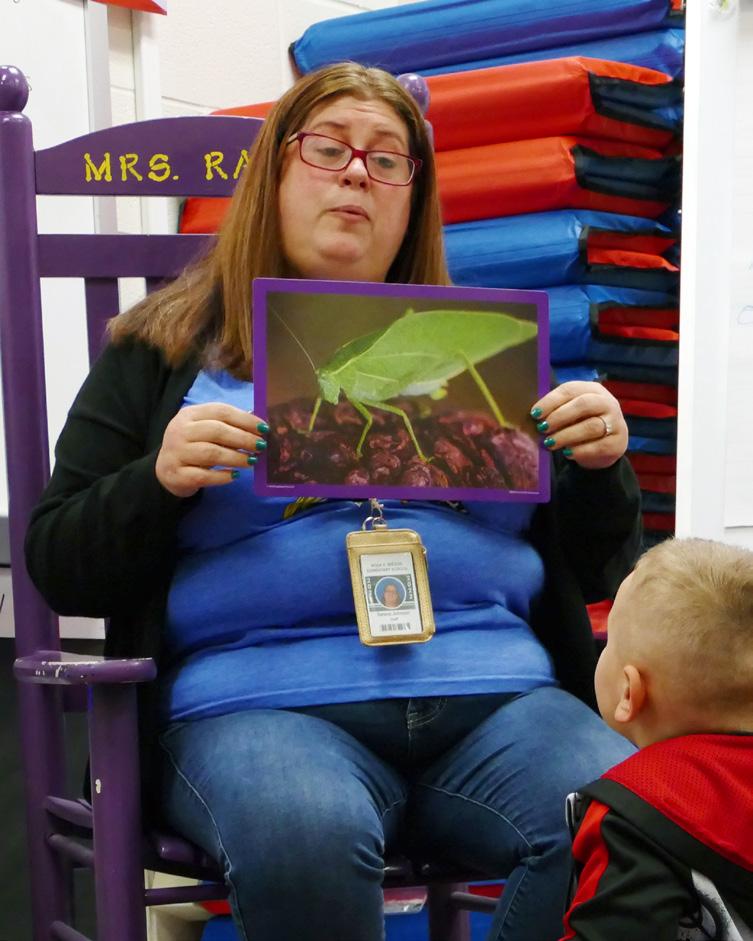
17
“Our family was really struggling. My husband at that time had been laid off from his job…and so I really wanted to work,” Johnson recalled. “In order to go back to work, I needed help with childcare for my daughter, and thankfully a spot opened up on the wait list for the Head Start program.”
went on to earn her bachelor's degree so she could step into a leading role in the classroom and help students and families come together, just as she was helped many years earlier.
It takes a passionate and driven person to become a Head Start teacher. It takes someone with a tremendous amount of empathy and love to serve vulnerable children and families. Thankfully, Johnson embodies all of those traits and more. She can relate to her students' parents because she has been where they are now. She understands what it is like to have to struggle and make impossible choices. Johnson’s parents did not graduate high school. She had been a single mom. She struggled to find work and support. It’s that shared experience that makes home visits and parent teacher conferences constructive and supportive.
Johnson’s involvement with Head Start did not end at being a parent. Almost immediately, she got involved in the classroom as a volunteer, and she soon became the classroom's de facto mom. From there, her love of children and desire to do more flourished. Her daughter’s Head Start teacher, Ms. Harrell, noticed this budding drive and nurtured it.
“[Ms. Harrell] was like, ‘You know, we really need substitutes. Would you like to sub?,’” Johnson explained, beaming with enthusiasm. “I never wanted to be a teacher. If you were to ask me growing up, I would have said, ‘No, not doing it.’ But I actually love it. I fell in love with it.”
Her journey continued from room mom to substitute teacher, but before long she knew she wanted to be more than an occasional substitute - she wanted to be in the classroom working with students every day. When an opportunity came to transition to being an instructional assistant, she took it. With support from her school’s Head Start program, Johnson earned the required Child Development Associates Credential to become an instructional assistant. She successfully balanced going back to school, working as a substitute teacher, and being a full-time mom of three. Nine years later, Johnson
“Head Start is not only a program that provides for the children, it also supports and provides for the families,” explained Rhonelta Yarborough, Region 10 Head Start Facilitator at Crandall ISD. “Johnson’s dedication to her students and classroom is a reflection of Head Start’s philosophy. I've been around since she was a Head Start parent, and I’ve seen that when she puts a plan in place and sets her mind to it, she succeeds.”
However, in typical Johnson fashion, there is always more to do. In the coming years, she plans on finding better ways to integrate the family into the classroom and instruction. Currently, Head Start parents are encouraged to work with their children to bolster the classroom curriculum, but Johnson knows she could do more.
“I really want to create a program where parents are welcomed into our classroom to share something with us about their family,” Johnson explained. “Even if it's reading their favorite book, or if they paint, maybe they can come in and show us how to paint a picture.”
As the day winds to a close and Johnson’s students wake from their afternoon nap, they stretch, gather their things, and sit on the carpet waiting for one last story. Johnson sits at the head of the classroom with her stack of books and materials to encourage a little more learning
18
“Head Start is not only a program that provides for the children, it also supports and provides for the families.”
before gym class and dismissal. Today’s wrap-up lesson is on insects native to Texas. The students count aloud the number of legs, “One, two, three, four, five, six!” and mimic the sounds of crickets. Once finished, everyone lines up to head to the gym. Each student gets a big hug, fist bump, or word of encouragement. After dropping her students off at the gym, Johnson returns to her classroom for conference time where she plans out the next day's lessons, activities, and home visits.
“If we can help one family be successful in a year, then we know we are doing our job,” Yarborough said. “Our job is not a job, it is a ministry to families and we see it daily in our children's faces and parents' faces.”
Johnson represents the very best in early childhood education and Head Start. She’s driven by a shared experience that she has with each Head Start family. Evolving from being a struggling parent looking for a job, to teaching a classroom full of some of the most vulnerable children, takes a unique person.
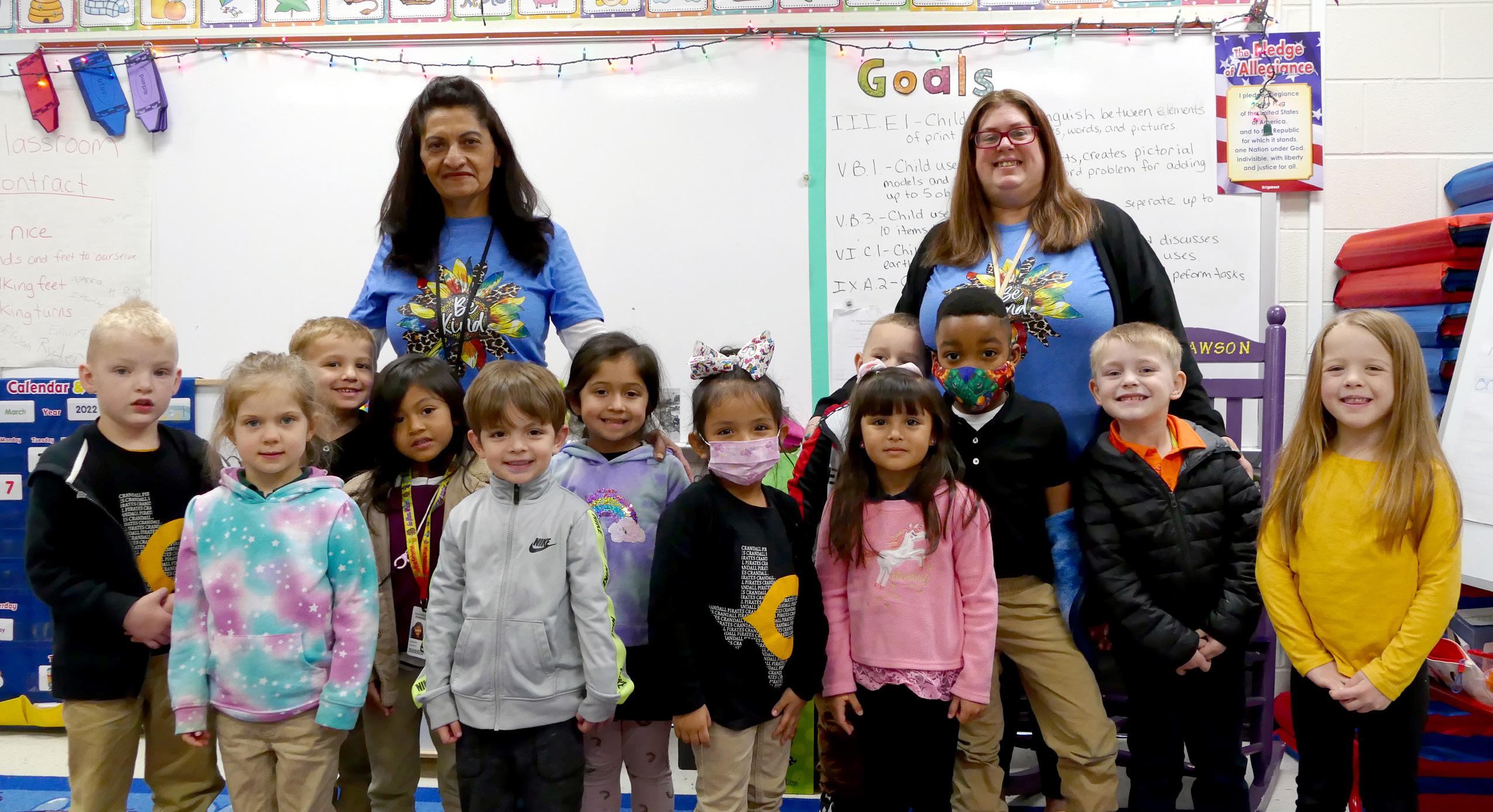
“I just love the Head Start program,” laughed Johnson as she tried to hold back tears. “We’re building a strong foundation not just for our students’ education, but also for strong
relationships for the families. I met my best friend in Head Start, and my daughter is still best friends with someone she met in Head Start. The Head Start program, to me, is more than just teaching - it's about relationships.”
Head Start is a federally funded program designed to nurture school readiness in preschool-aged children from families who are economically challenged. The program is family focused, and teachers work directly with parents or key family members to foster positive relationships, encourage the family to be leaders in their child’s education, and provide stability and support for those who are most vulnerable. Head Start takes a holistic approach to education, understanding that a well-rounded education is not just reading, writing, and math - students need to be healthy, supported, and loved.
To learn more about the Region 10 Head Start/ Early Head Start (HS/EHS) program, contact Kelly Skwarek, Region 10 Director of HS/EHS.
kelly.skwarek@region10.org
19
Buzzing with Pride
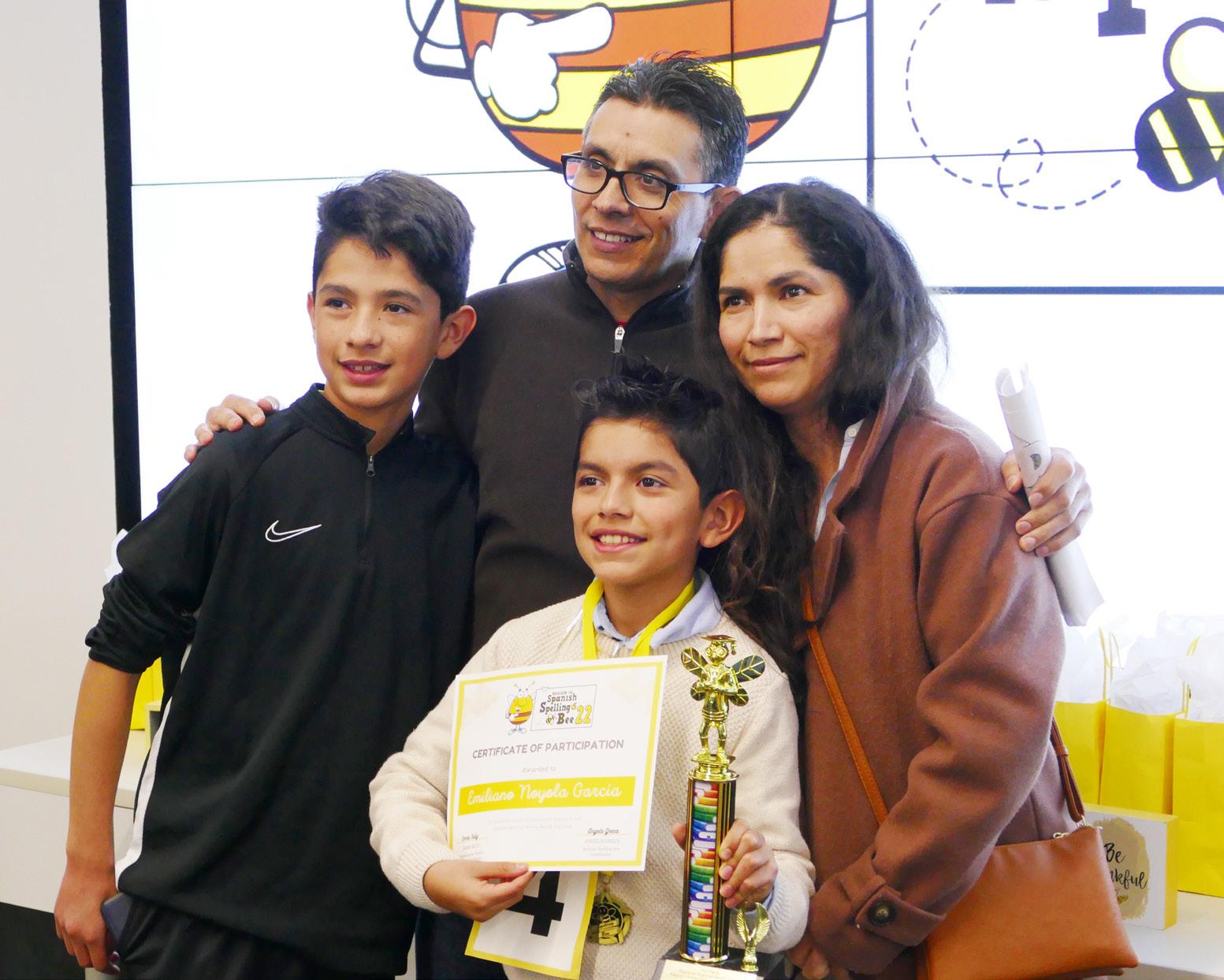


20
AUTHOR: MAX SMITH Region 10 Digital Marketing Specialist
EXCITEMENT. Pride. Nervousness. These emotions were all in the air as 28 students from 11 school districts came together to celebrate the Spanish language during the 2022 Spanish Spelling Bee at Region 10. This year was the sixth annual Regional Spanish Spelling Bee, and the first time it has been held on-site since 2019.
For Region 10 English Learner Support Consultant Angela Greca, the Spanish Spelling Bee celebrates and honors being a language learner.
“Generations of language learners have grown up in a deficit-based second language model –meaning you erase the home language in order to acquire the target language. In our case, that has been English,” Greca shared. “This includes my grandmother, who grew up in the Rio Grande Valley in South Texas. They were punished for speaking a word of Spanish at school, including while playing on the playground. We need to recognize that multilingualism is something to celebrate, always. When people hear that I am multilingual as a native English speaker, they always congratulate me for an amazing accomplishment. If you think I am so amazing, why don’t you also think the students who are doing the exact same thing but with greater proficiency and at a younger age are even more amazing?”
Three separate competitions were held; third grade, fourth-fifth grade, and sixth-eighth grade. The first Spelling Bee of the day, the third grade competition, saw Diego Ramirez from Denison ISD take first place.

“I'm so proud of Ramirez, because he has been working hard to study the words ever since we had our spelling bee in the school,” Denison ISD’s Yencys Rodriguez said.

Winning did not come easy for Ramirez, who faced some challenges in the final round.
“I had trouble with the word that I won on, but I am very happy that I won,” he recalled.
The fourth-fifth grade Spelling Bee saw 11 students compete in a highly competitive
21
round, with Emiliano Noyola Garcia from Wilson Elementary in Coppell ISD claiming first place. This wasn’t the only highlight of Garcia’s day. After taking home the top prize, he went on later that day to perform the leading role of Aladdin in his school play.
“He represents the best of what we see for our kids, as a part of our dual language program,” Principal Cooper Hilton shared. “When I think of Garcia, I think of hard work, whether it's in preparation for the Spanish Spelling Bee or our school musical extracurriculars that he's a part of.”
According to Principal Hilton, Garcia had the full support of his teachers.
“I was texting his teachers while he was competing, and they said they were screaming
so loud, they were worried that he could hear them all the way from Coppell,” Principal Hilton shared with a laugh.
For Dr. Patricia Dawson, Coppell ISD’s Director of ESL Bilingual, participating in the Spanish Spelling Bee is a very rewarding experience not only for the students, but also for the educators.
“I think having the Spanish Spelling Bee brings validity to the Dual Language program, and to our incredible culture and language of our native Spanish speakers in the district and around the state,” Dr. Dawson shared. “It speaks highly of the amazing educators who work hard in these programs each and every day and put forth excellent education, both academically and linguistically.”
The final Spelling Bee of the day, the sixtheighth grade competition saw Garland ISD’s Andrea Cueva and Faith Family Academy’s Lucy Gonzalez go back and forth through multiple rounds, before Cueva finally ended up taking first place on the eve of her birthday.


“I was so nervous at the start, I felt like passing out for a little bit. As the competition went on, I wasn't as nervous,” shared Cueva. “I'm super proud of myself because I never thought I could do it, but I put myself to it and I accomplished it.”
Cueva wasn’t the only one feeling all the emotions of the competition, according to Garland ISD’s Esther Bellah.
22
“We were watching so closely and just crossing our fingers through the ups and downs,” Bellah shared. “It's a roller coaster of emotions, but it was really fun.”
Cueva thanks Bellah, Garland ISD LOTE Coordinator Laura Parker, and her Spanish teacher Mr. Cardona for their support. She also thanks her mother, who would practice the words with her in the car. While Cueva is a talented speller, spelling isn’t her only talent.

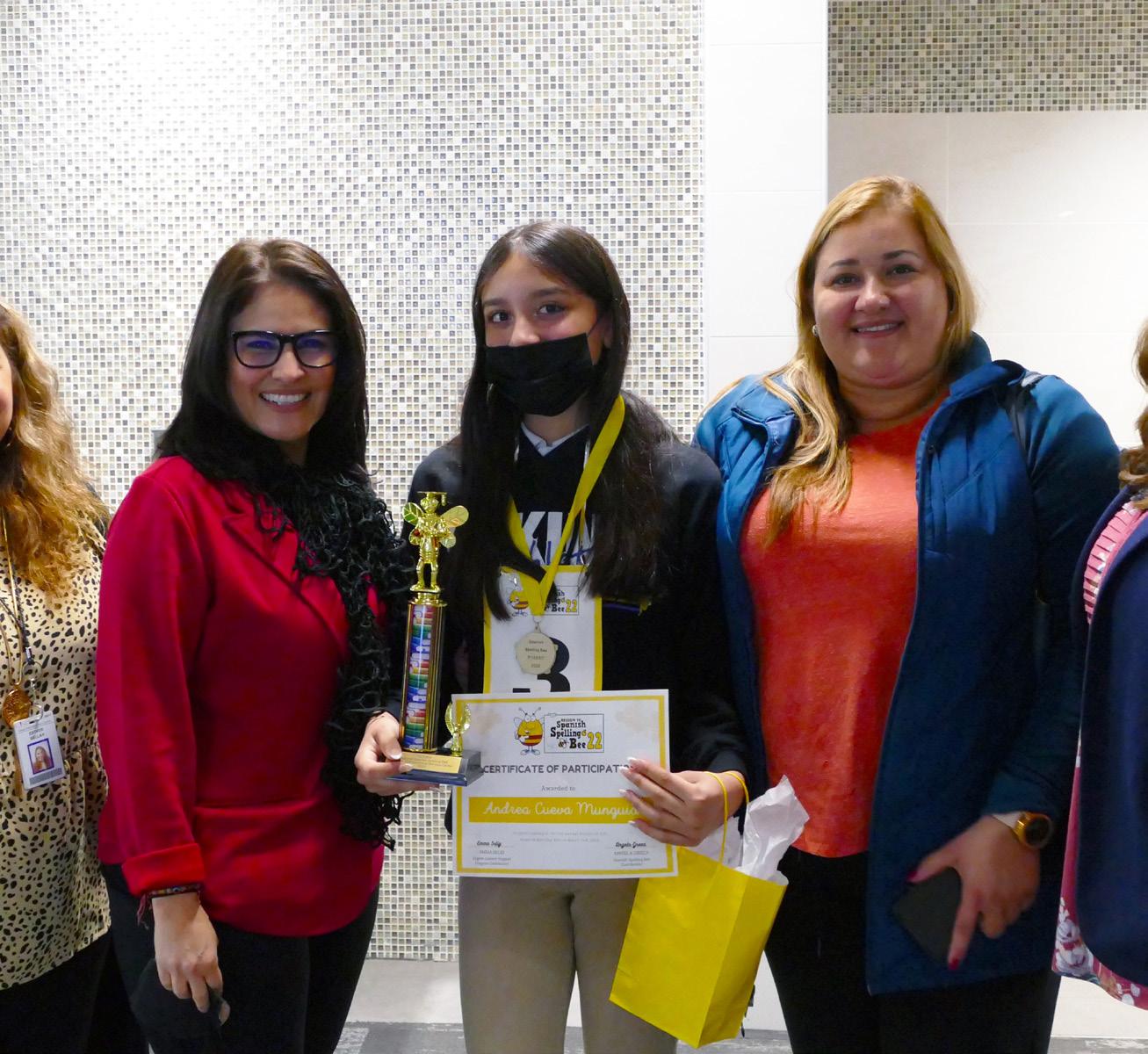
“Yesterday, I also won first place at a track meet,” Cueva shared. “But I think I am better at spelling than track.”
The day left a profound impact on Texas State Representative Ana-Maria Ramos, who was one of the judges.
“Today was really quite emotional for me, seeing that these children still are nurturing their cultural connections,” Ramos reflected. “I'm very honored to be here with future presidents, lawyers, teachers, and even my future replacement right here in this room.”
While there were three winners, every participant
“I never competed in a spelling bee as a child, I was always too scared. I hope they realize the level of courage they have, and the admiration I have for them for participating in something that's not easy,” Ramos shared. “I was intimidated just being a judge, because even though I do speak fluent Spanish, it's a different level. These kids bumped it up 10 notches."

23
Partnering for Friendship
AUTHOR: MAX SMITH Region 10 Digital Marketing Specialist
THE bell rings for fourth period at Royse City High School, and it is workout day for Coach Tayler Young’s Partner PE class. One by one, students trickle into the gym, and the class begins with some stretches led by one of the participants. While they are stretching, Coach Young and her Partner PE peers set up the stations for today’s workouts.
This class is a smaller class, with four students rotating around the stations in intervals. At each station, they work on exercises, such as sit-ups and push-ups, with one of

the Partner PE peers. In the weight room, the students do arm exercises with hand weights. While the workouts are going on, Coach Young keeps a loose, fun atmosphere by playing music over the speakers - she even takes special requests from her students.

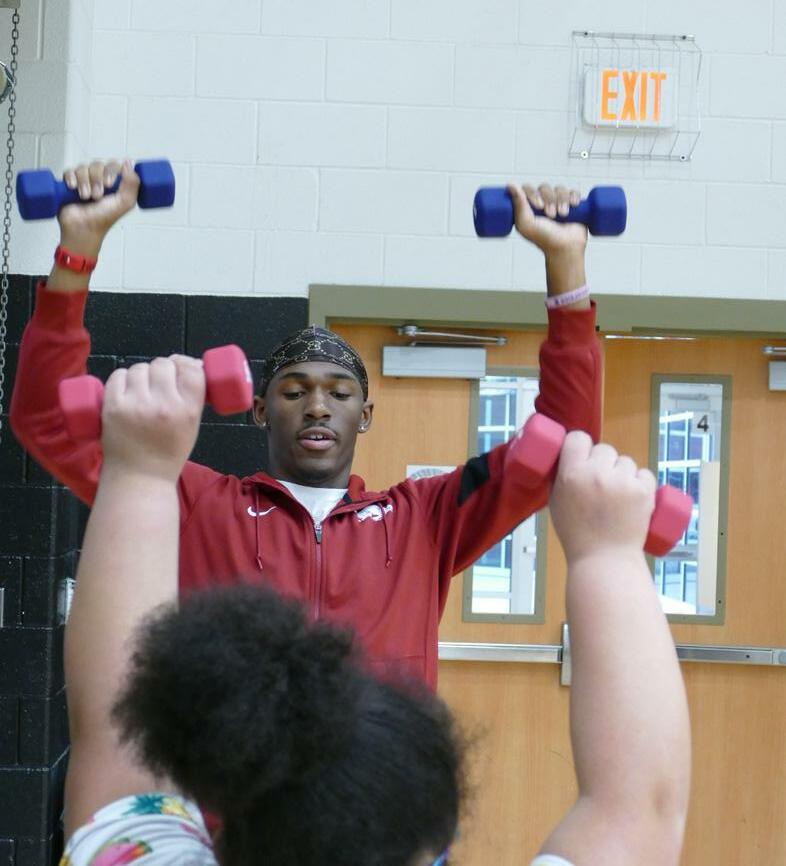
Since its inception 10 years ago, the program has grown from one class into three separate classes, which take place from fourth period through sixth period. Each class is designed according to the different needs and functions of its participants.
“The fourth period class is smaller, more oneon-one, because there's more need. Fifth period is a little bit bigger, with the higher functioning students. Sixth period, those are a lot of my nonverbal kids that need a lot more one-on-one attention,” Coach Young explained.
24
Many Partner PE programs that have these same characteristics are found in larger school districts that have their own Adapted PE specialists. Despite the smaller district size, Royse City’s General Education PE teachers have stepped up in a big way to run the program, according to Hannah Reynolds, Region 10 Adapted PE Specialist, who works with Coach Young.
“It has allowed for the emphasis to be placed on inclusion and involving the general education population with the students in special education,” Reynolds shared.
Reynolds has been amazed by the ability of Coach Young to show such dedication to the program’s success while also serving as the coach for girl’s basketball and golf. For Reynolds, Coach Young has done a great job of building relationships and making everyone feel included in the class.
“It amazes me every day that she not only takes on these coaching roles, but also is so dedicated to her Partner PE class periods by forming trusting relationships with her partners, who typically assist in a large part of the setup and day-to-day activities in the class. She truly cares for the development of each student in special education who attends her class,” shared Reynolds. “She has a natural ability to make anyone feel like part of the team and included in whatever they are doing no matter their disability.”
Coach Young tries to keep the classes similar to the General Education PE classes, with added structure and routine to fit the needs of the Partner PE students.
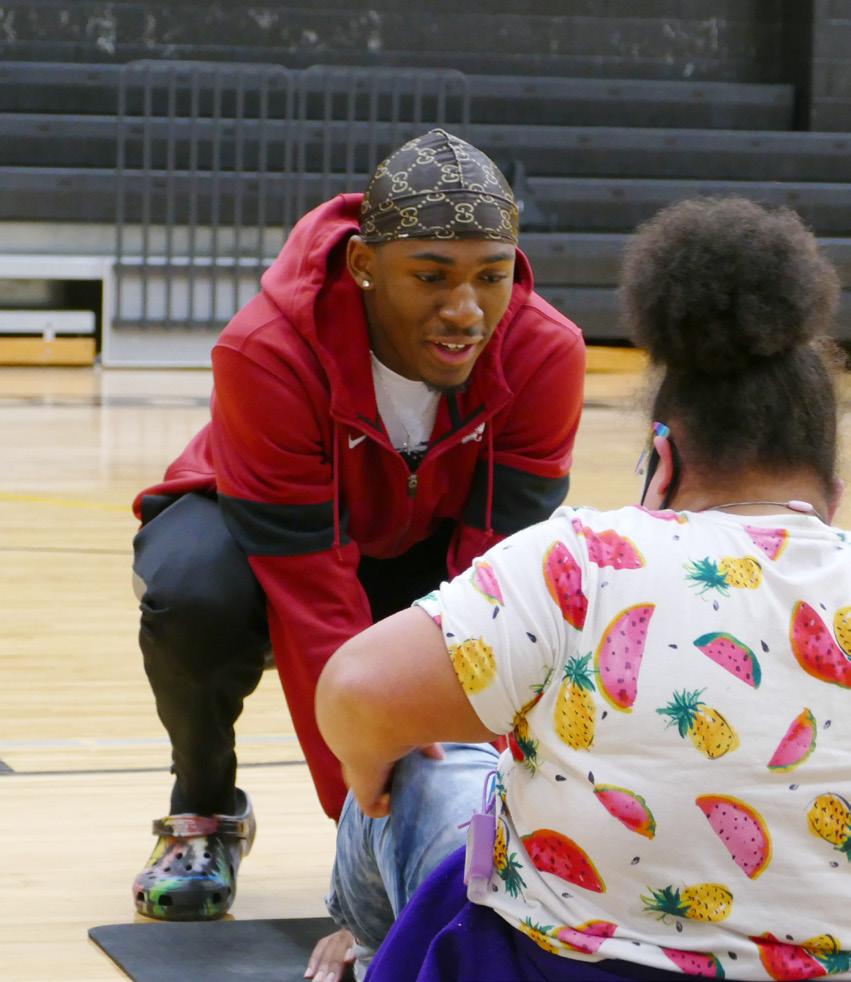
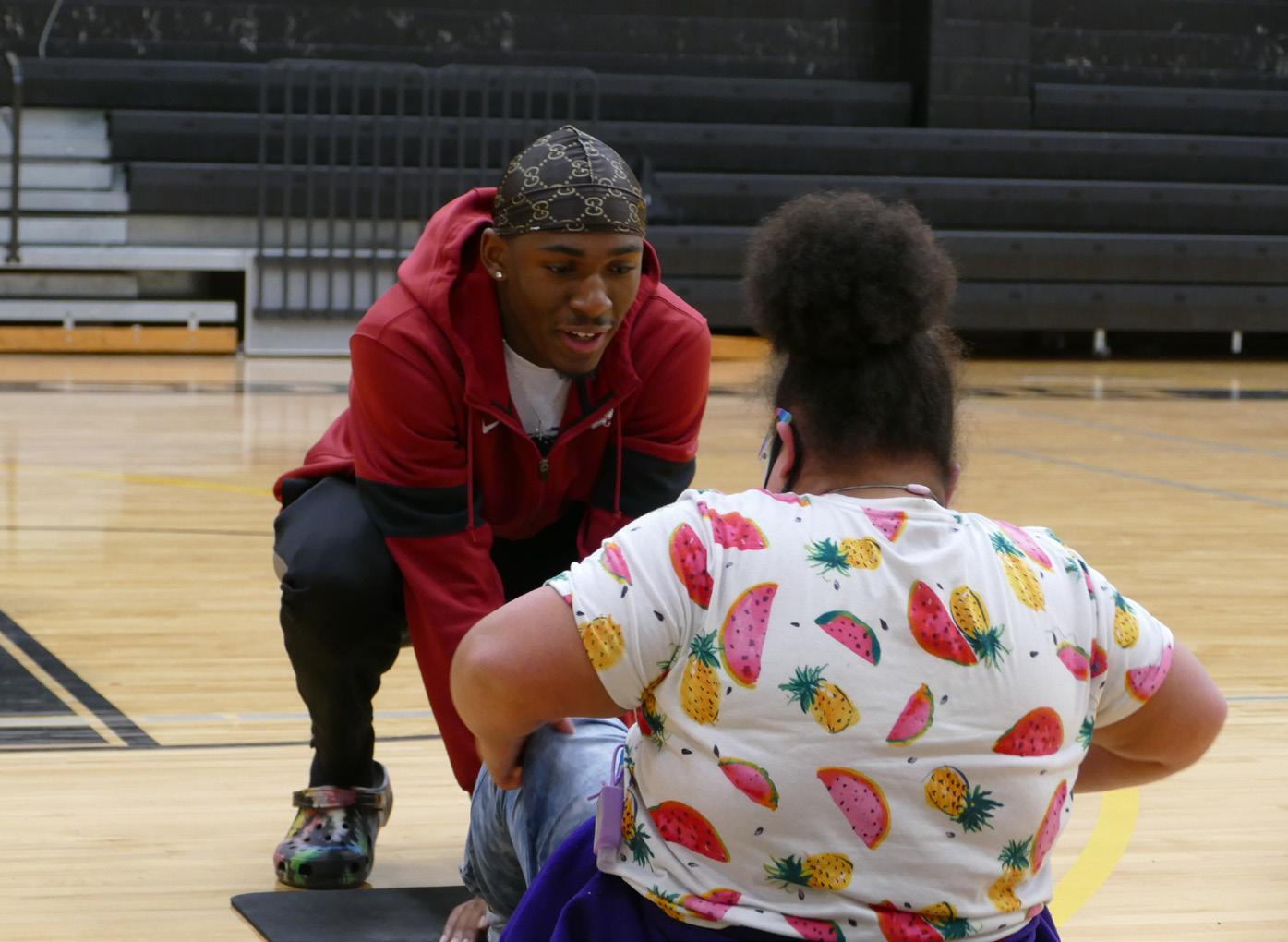
For Emily Teal, a student at Royse City High School who serves as a Partner PE peer, building relationships with the participants is one of her favorite aspects of the program.
“When you come in here, it's not about you. It's 45 minutes that are all about the kids and making sure that you're the best role model and friend
for them,” Teal said.
These relationships the peers have built with the participants, and the commitment they have shown to them, has been one of the most notable aspects of the program to Reynolds. She credits much of the success of this particular program to Coach Young and the school staff for recruiting students who are mature, patient, and compassionate.
“I know that most of the students are high school athletes who could be using this class credit and time to do something else, but they instead choose to completely invest in the Partner PE program and form personal relationships with each student in their class period,” Reynolds shared. “They all have committed to the program 100 percent, and they each serve a unique role in the class curriculum and development. It creates a program that allows these students in special education to feel a sense of inclusion and belonging, while learning the important social skill of forming relationships with peers. They also learn about different sports and fitness activities that they can use after graduating.”
In her time coaching the class, Coach Young says she has seen the Partner PE peers get more out of the program than the participants. In addition to developing various skills, the peers are provided an opportunity to build relationships with students who they may not get to interact with on a regular basis.
“The Partner PE peers learn patience, they learn leadership skills, they learn to be accountable. When they join this class, they become more attentive to other people and their needs,” Coach Young shared. “They build genuine relationships, and sometimes I think these relationships are even stronger than their relationships with their friends.”
25
Points of Pride REGION 10 Points of Pride
The newly developed two-year school improvement framework transformed the way Region 10 supports LEAs. This framework includes comprehensive professional development, implementation support, and coaching services aligned to Texas Instructional Leadership and the Effective School Framework. It extends services Region 10 currently provides, and layers in building-level training and support in a way that hasn’t been done by an ESC until now.
Region 10 provided virtual/online services and supports through Direct Student Services to more than 1,300 students virtually and inperson during the pandemic. These services included virtual crisis counseling support, behavior classroom coaching, and a Facebook live series for parents that reached more than 20,000 participants.
The individualized support the Region 10 Head Start program provides for teachers and instructional assistants surpasses the state requirements for high-quality pre-k including 30+ hours of professional development with a focus on best practices for early childhood instruction, direct coaching in excess of the required 15 hours, and intervention for students with behavior challenges. Our team goes above and beyond to ensure all families are supported through a wholistic approach to include health/wellness, parent engagement and high-quality instruction.
Through multiple partnerships, Region 10 now provides certification to Human Resources staffs. Through the Professional Human Capital Leaders in Education (pHCLE) certification, HR staff learn to manage human capital decisions, balance strategic and transactional HR practices, maximize the use of data, use branding and communications, and understand the relevant federal and state laws. This training is not only offered across Region 10, but also to HR teams across the nation.
I N D I V I D U A L I Z E D S U P P O R T
S C H O O L I M P R O V E M E N T F R A M E W O R K H U M A N R E S O U R C E S C E R T I F I C A T I O N
V I R T U A L /O N L I N E S Y S T E M S O F S U P P O R T
The Region 10 Administrative Services team has developed a new training titled “Leading with Distinction in Turbulent Times.” This training, which was identified as a need during COVID, is designed to help the superintendent and their school board get back to good governance and oversight while focusing on academics and strong goal setting. In addition, Administrative Services provides talking points on hot topics and demonstrates to school board members how to use bridge language to turn difficult questions into positive messaging. Additional Team of Eight trainings include how to be best prepared as a new board member, and how to create and maintain strong leadership between the superintendent and board for the best district outcomes.
The new Region 10 Reach! magazine, which is published twice a year, highlights the amazing work Region 10 staff are doing to support and positively impact our educators and students every day. The magazine also features feel-good stories from schools across the region. In addition to sharing our stories in the magazine, Region 10 has stepped up its social media presence. Over the past year, Region 10 gained 1,700+ new followers on Facebook, Twitter, and Instagram.
The Region 10 Technology & Data Services cloud and colocation services directly impact a school district's network performance, security, and service availability. Utilizing Region 10 to co-locate equipment, or taking advantage of managed services such as BaaS (Backup-as-a-Service), ensures critical service/data is protected from any potential malicious threat.
The Region 10 Distance Learning and Digital Learning teams are collaborating to build Professional Development. These Microlearning Courses are tailored for busy educators who need to learn bitesized chunks of information in the shortest time possible. Each course is designed to deliver content in as little as 15-30 minutes.
C L O U D & C O L O C A T I O N S E R V I C E S P R O F E S S I O N A L D E V E L O P M E N T I N A B O X
S H A R I N G O U R S T O R I E S
T E A M O F E I G H T T R A I N I N G S CONNECT WITH REGION 10 @Region10ESC

28
Support Pup in Training
AUTHOR: RACHEL FROST Region 10 Chief Communications Officer
BURNEY SITS PATIENTLY on the curb as buses enter the school parking lot one by one. This is his favorite part of the daygetting to greet his little friends as they get off the bus! The students seem equally excited to see his sweet face, floppy ears, and wagging tail.
After a quick bathroom break, he heads over to the car rider line to make sure all of his friends are happy and accounted for before the school day begins. During the morning announcements he takes a quick snooze and then he’s back to work - making rounds to classrooms to visit his buddies.
Much like the three-, four-, and five-year-old students at Terrell ISD’s W. H. Burnett Early Childhood Center, Burney is in the early days of his education. With lots of encouragement, guidance, and a seemingly endless supply of treats, he’s well on his way to becoming the campus therapy dog. Though he’s only a few months old, Burney’s mom and campus principal, Jodi Schleter, explains that he has the perfect temperament for the job.
“He is so well behaved...He was just chill from day one. He doesn’t have any of those typical
puppy characteristics,” Schleter said. “When I first saw his picture I was joking with some of the staff that we needed this dog. That night I went home and started researching, and I realized that this idea of having a campus therapy dog has become a thing. I just decided that this is exactly what our kids need right now.”
There’s something about the clumsy cuteness of a puppy that puts people at ease. As Burney walks through the halls and visits classrooms, you can see the joy he brings to the young students and staff. Emily Kefayati, who serves as a campus
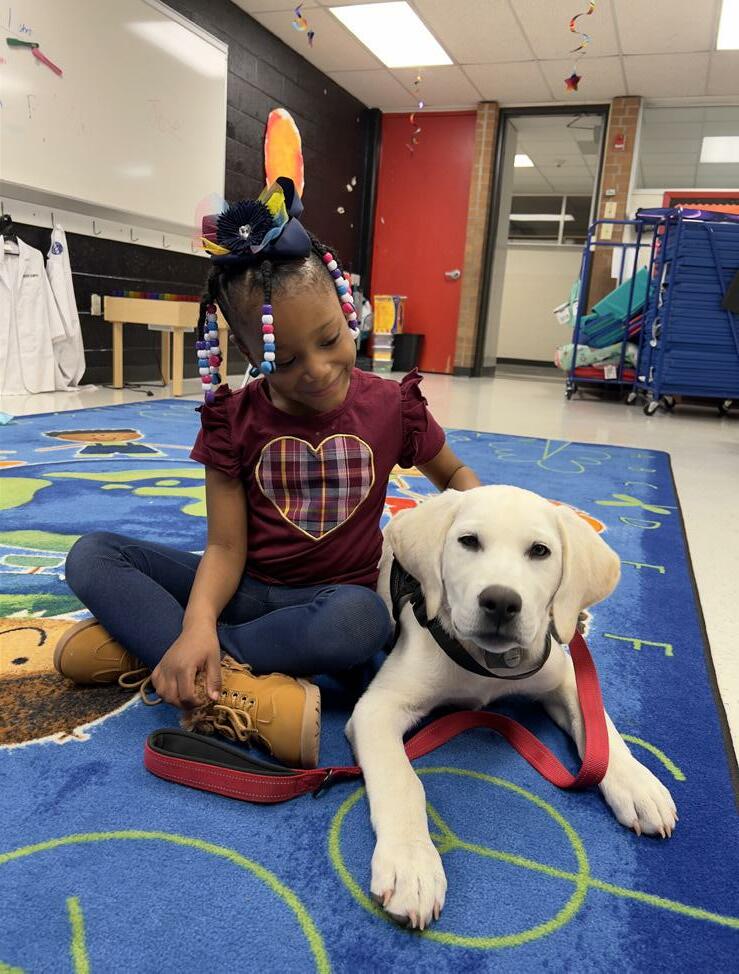
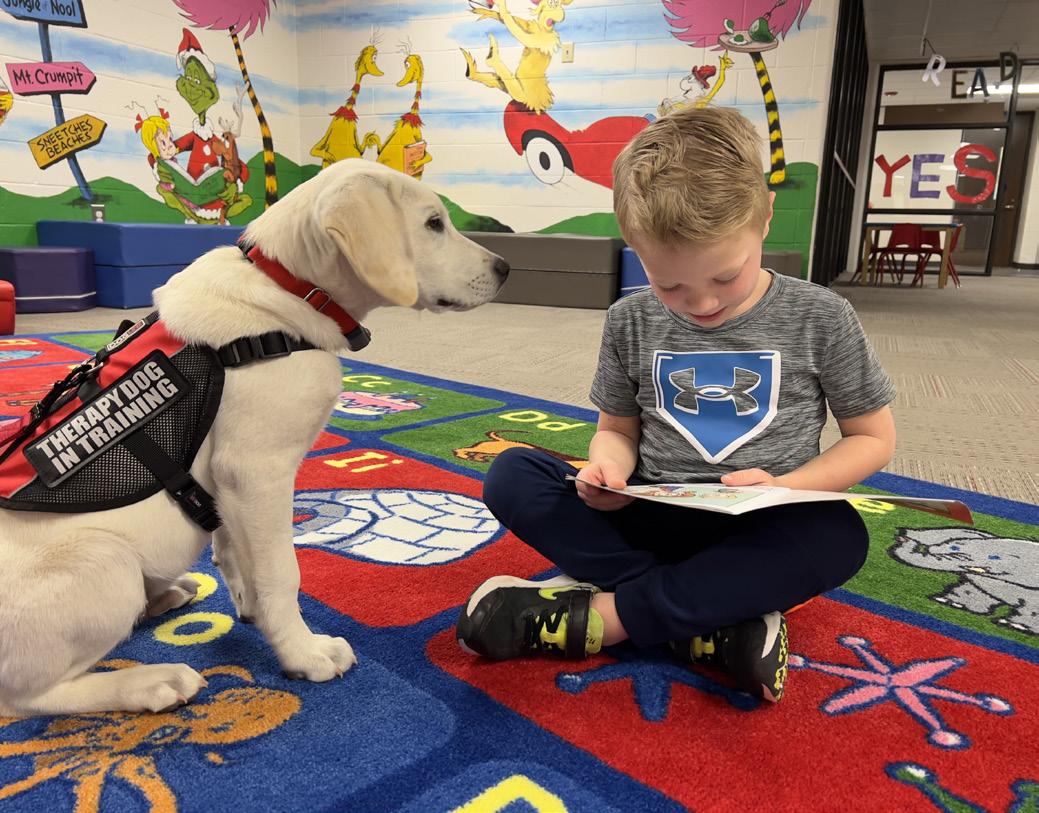

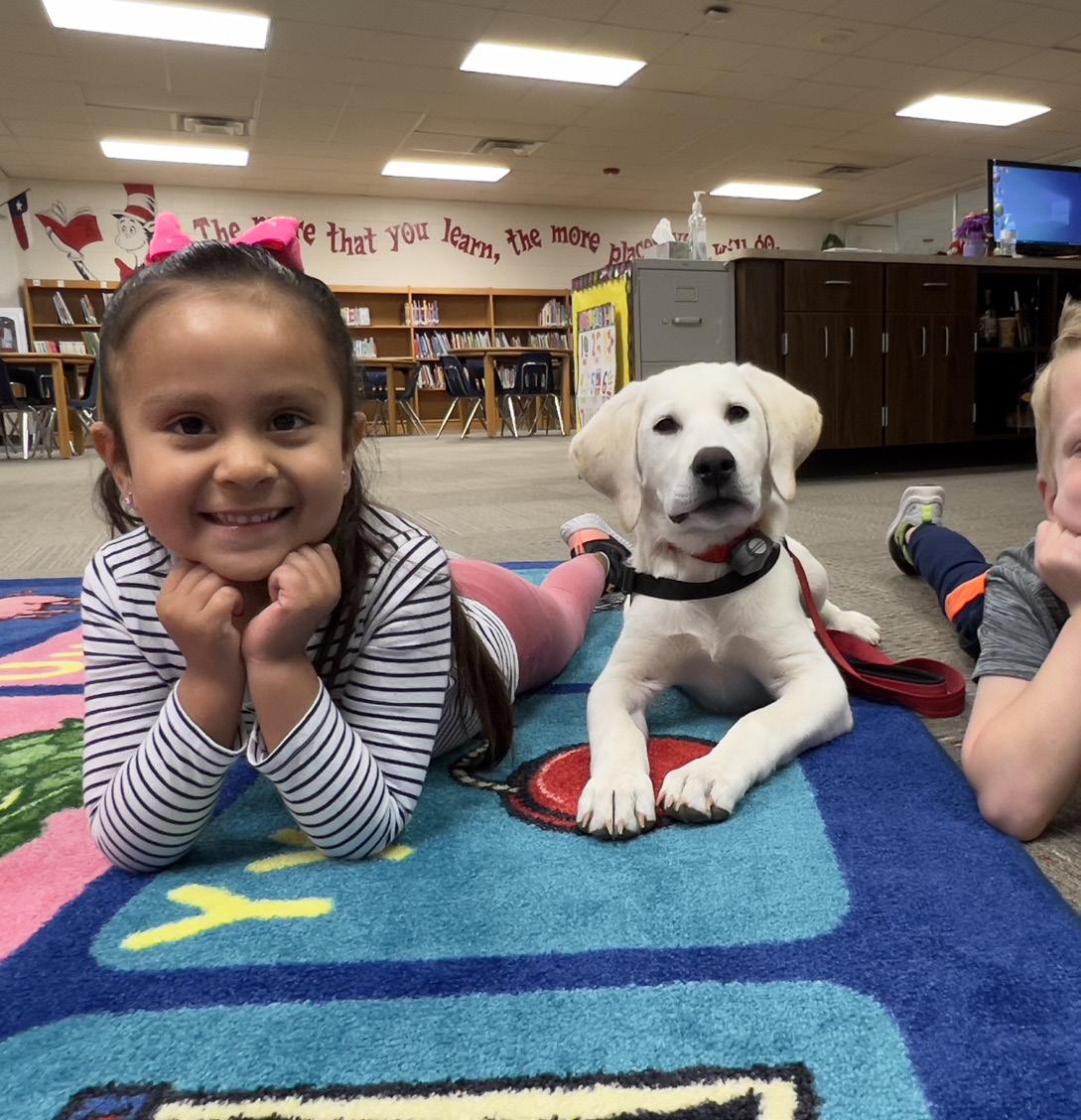
29
behavior specialist and is a self-proclaimed dog lover, has started envisioning the various ways she can put his training to good use.
“We have a particular student who has already benefited so much from Burney being here. We don’t get a whole lot of verbal interaction from this student very often, but he will talk to Burney. You know, the student won’t communicate with us, but he will communicate with the dog, and that’s beautiful,” Kefayati shared. “I think there’s a lot of benefits of having a therapy dog, and I am really excited about our kids getting to be exposed to that.”
For now, Burney’s main job responsibilities include greeter and dismissal duty, hall walker, and classroom visitor. Once he completes his extensive training, the goal is for him to be a resource to deescalate kids and help them calm down when they’re having a rough day. Schleter sees him becoming part of their campus culture, and serving students at other campuses and the community at-large.
Though he’s only a few months into his training, several parents have started seeing changes in their children from having Burney at the campus.
One of those parents is Tanzi Hambrick, who also serves as a Head Start aide on campus. Hambrick was initially a bit nervous about having Burney around due to her fear of animals, but it didn’t take her long to warm up thanks to Burney’s calm nature and friendly disposition. Meanwhile, her four-year-old daughter Promise took to him right away.
“Burney is special because I had a fear of dogs, and he helped me open up. He has really had a special effect on my daughter. She wants to come to school every morning to see Burney,” Hambrick shared. “At home she is always wondering about Burney, and asking questions about what he might be doing. She doesn’t see Burney as an animal, she sees him as a friendhe’s her best friend.”
Burney is a best friend, a quiet reading buddy, and a source of unconditional love for the students he serves.
“He has really had a special effect on my daughter. She doesn’t see Burney as an animal, she sees him as a friend - he’s her best friend.”
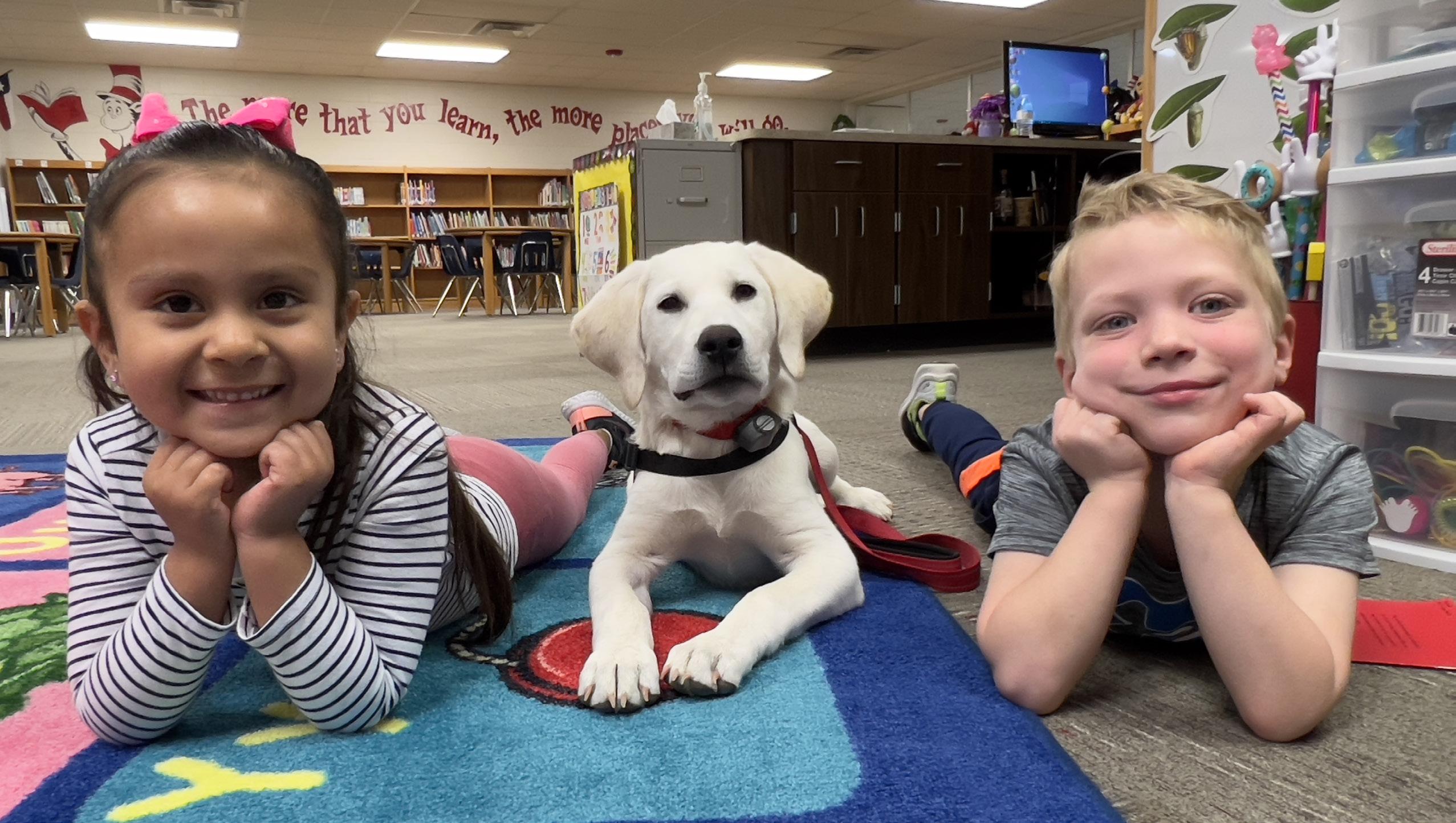
30
ClimateChange Understanding withMath
FionaGoddard -EducationConsultantatWhizzEducationandFormerTeacher
Inanumberofherspeeches,Greta Thunbergmakesitclearthat climatechangeshouldbespoken abouteverywhereandoftenwith
the kind of gravitas that the earth’s predicament warrants. She marvels in her speech entitled ‘Almost Everything is Black and White’ (2018) that ‘the vast majority of people don’t have a clue about the consequences of our everyday life’. This is something that teachers are well-equipped to change.
Math education is essential in developing an understanding of climate change and that learning will help students to deploy their math in innovative, world-changing ways.

Whizz Education is delivering a suite of free learning activities across disciplines that will focus on the topic of ‘Building for the Future ’ Activities will be based around the UN’s Sustainable Development Goals 7, 9, 11 and 13. They will encourage children to learn about the environments in which they live and to support the development of a sustainable world with a focus upon sustaining mathematical ability, in measurement and geometry.
Without numbers, students would not understand ideals like the carbon budget or the limit of 1.5 degrees of warming at the centre of climate
changedebates.Withoutusingdata tothinkabstractly,oursensesand observationsalonewouldnotconfirm thatclimatechangeisoccurringor thatweneedtoact.
Discussingclimatechange, celebratingworldenvironmentday, initiatingprojectsforstudentsto improvethesustainabilityoftheirown school(forexample,byreducingfood waste)orstartingclubsmightbejust someexamplestohelpsavethe environmentandcouldhavea profoundimpactonthefutureofthe planetandcanbeusedtocultivate ever-importantmathematical knowledgeandskills.
Whynotgetinvolvedandencourage yourschooltojoin-inwithWhizz Education’sBuildingfortheFuture activities?Forexample,students couldbemeasuringrainfall.Theywill beelevatingmathskillsbycollecting andrecordinghowmanyinchesof
liquidarecapturedonadailybasis anddiscussinghowtomakethe recordsuseful,fairandimpactfulin thefuture?
Aswellasteachingstudentstohandle numbers,thesummerprojecthasthe capacitytoinspire,engageand empower.Numerousstudieshave shownthatclimatechangeeducation hasthebiggestimpactwhenstudents areencouragedtotakeresponsibility forlearningaboutissuesthatimpact themandtheircommunities.Help makeadifference!
WhizzEducationisaneducation partnerdedicatedtoimproving learningoutcomes.



Forfurtherinformationandtoaccess freeresourcesfromWhizzEducation’s climateprojectpleasesee: https://www.whizz.com/en-us/ summer-challenge-2022/




AdvertisementFeature
info@whizz.com
ww w .wh izz com /e n-u s /


Listening and Learning
AUTHOR: MAX SMITH Region 10 Digital Marketing Specialist

COLLABORATE and listen. If one had to sum up what the duties of a mentor teacher are, those two words would be a good place to start. Few mentor teachers have done this better than Braiden Foster, who has been a source of support for first-year teacher Nicole Lotts at Mt. Peak Elementary in Midlothian ISD.
Foster, who is in her fourth year of teaching fifth grade, took on the role of being a mentor teacher at the suggestion of Principal Adam Henke.

“We were scoring my campus involvement during my summative review at the end of last year. I don’t remember my score, but Principal Henke said, ‘I think you can get something higher than that. I really want to see you take on some more leadership roles. How do you feel about maybe taking on a mentor position next year?’” Foster recalled, “I was like, ‘Sign me up! That sounds great!’ I was excited to be offered the position.”
When new teachers were matched with mentors at New Teacher Orientation, Foster was excited to be assigned to Lotts since they had prior experience working together.
“She student-taught here last year, and ended the year as a Pre-K aide. When I saw her at the New Teacher Orientation…I was like, ‘Oh, my gosh, you're here!’” Foster shared.
Foster’s background as a Special Education aide, along with her prior experiences addressing behaviors while teaching, have helped her to empathize with some of the issues Lotts has encountered as a first-year teacher.
“My experience working with younger children who are working through big emotions has definitely helped me when working with Lotts because she's had quite a few students in her room who needed additional behavioral support and different things,” Foster shared. “I am able to reassure her that you just have to keep tryingyou're going to find that thing that will work.”
Through trial and error, Foster believes Lotts’ classroom management strategies have grown tremendously throughout her first year.
“Lotts has gained some amazing strategies throughout this year in regards to classroom management,” Foster explained. “I think classroom management is such a daunting task as a new teacher, because it truly takes time and trial and error to figure out what is going to work best for each group of kids. She has been very willing and motivated to serve her students by changing and evolving management skills that work best for her and for them.”
One of those strategies is a dedicated space in Lotts’s classroom called the “Calm Down Corner” where students can go when they are working through their heightened emotions.
“This is a safe place for my students to go when they have big feelings so they can self regulate.
33
“I am also constantly evaluating the needs of my students and making changes to my strategies that I see are necessary in order to effectively handle each new scenario.”
There are tools and strategies in this space to allow them to choose a technique that is going to best help them,” Lotts shared. “If they need additional support while calming down, I am able to go over and help model for them and give them ideas on how they can choose to calm down.”
Aside from the “Calm Down Corner,” Lotts has also been intentional about building selfregulation strategies and problem solving strategies into daily lessons so that her students learn how to appropriately work through difficult situations.
“I am also constantly evaluating the needs of my students and making changes to my strategies that I see are necessary in order to effectively handle each new scenario,” Lotts explained.
When Lotts finds herself fresh out of new strategies to address the unique needs of her students, that’s when she turns to Foster for collaboration and support.
“Foster is always more than willing to help me with anything I need, and she does it in a way that my experiences in my classroom and my knowledge of my students is validated,” Lotts shared. “She asks questions and listens first before making suggestions to know what I’ve tried, and then we can work through ideas together. Our time together is very much collaborative, and I think that speaks volumes about Foster as a mentor.”
According to Shari Dawson, Region 10 Mentor Teacher Consultant, these qualities allow Foster to work effectively with virtually any mentee.
“The thing that really stands out to me about Foster is that she has a servant’s heart and she's a very good listener,” Dawson shared. “In my opinion, those are the top two things that any mentor teacher needs to have. I don't care what grade they teach or what content they teach. I think you can partner those kinds of teachers up with any teacher.”
Foster has felt supported by Dawson and the Region 10 Mentor Teacher program. For her, the program’s professional development sessions have given her a space to work with teachers she doesn’t normally work with. She also appreciates the one-on-one check-ins with Dawson, who visits a select cohort of 60 mentor teachers at their campuses twice in both the fall and spring semesters.
While Foster initially felt unqualified to be a mentor, she received plenty of encouragement from Holly Rogers, her Lead Teacher, and the rest of her teaching team. Now that she has been working as a mentor teacher, she encourages younger teachers to try their hand at it as well.
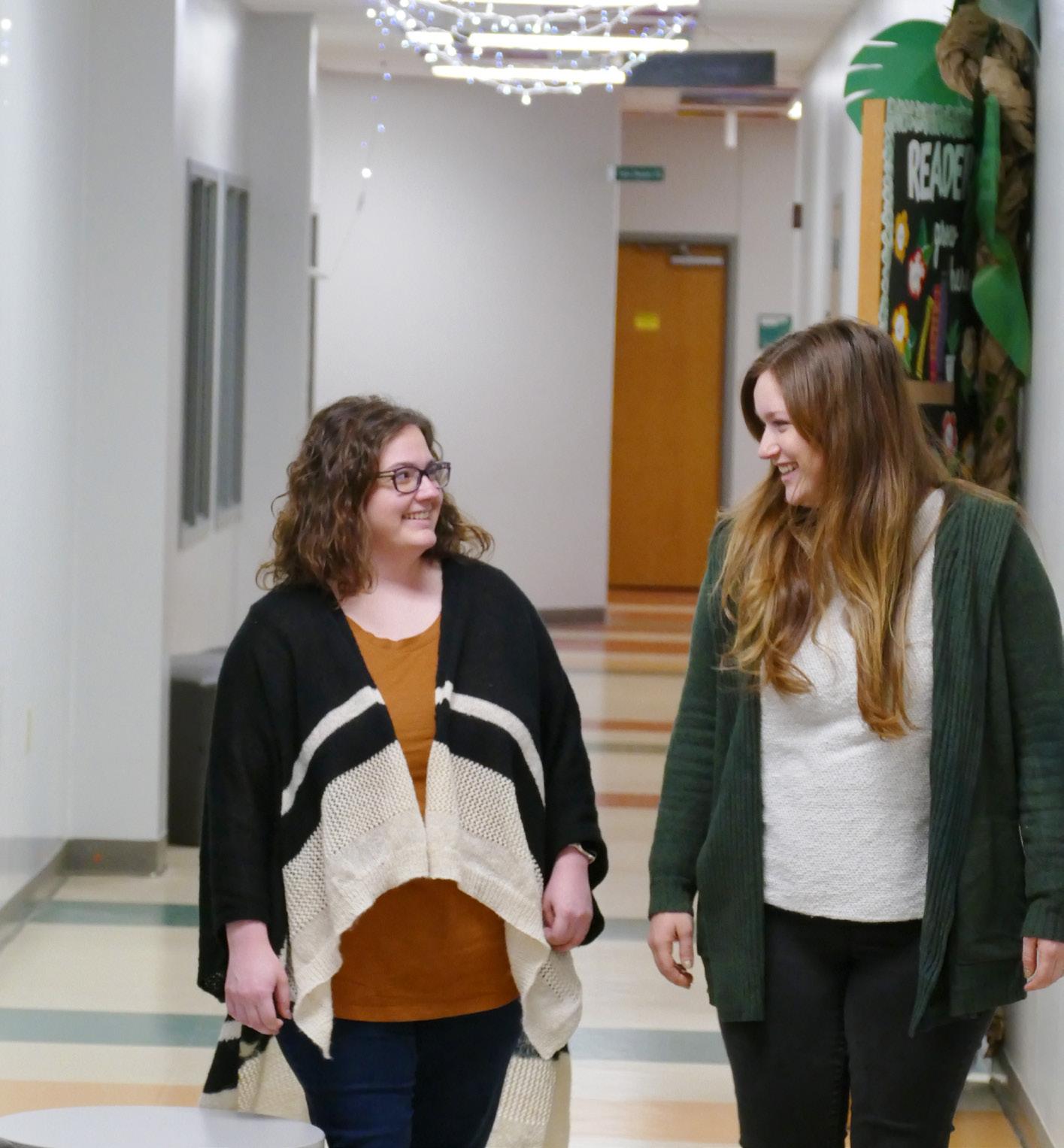
“I always try to remind people that experience doesn't always equal truth,” she shared. “It’s not always about how many years you've been doing something. It's just, are you willing to even try?”

34

Supporting School Nurses
AUTHOR: RACHEL FROST Region 10 Chief Communications Officer
IF you want to make a school nurse laugh, ask them what a “normal day” looks like in their world. In the first few weeks on the job, Krystal Rigsby was juggling helping a kid who got his eyelashes stuck in his bottom eyelid from rubbing his eyes too much, with another kid who took a bad fall on the playground. For Rigsby, the transition from working with dialysis patients for 16 years to working with young students has been both a whirlwind and a rewarding experience.
“My transition to school nursing has given me and the schools I serve a greater insight into the importance of having a nursing professional available for our students,” Rigsby explained. “I have been able to step in and provide health education and services to the students and staff in districts that haven’t had a nurse in 30 years!”
The need for experienced school nurses was magnified at the height of the pandemic, when school nurses were faced with caring for sick students and staff and tracking COVID cases on top of the day-to-day bumps and bruises, ongoing health screenings, and loads of paperwork.
“What we were finding is that smaller districts or even the charter schools were having a hard time with hiring because of their geographic location. Since there was not a large pool of potential applicants, Region 10 decided to hire them as our employees,” Ginger Riggins, Region 10 Nursing and Health Program Coordinator, said.
Thanks to funding through the COVID-19 Public
Health Workforce Supplemental Grant, Region 10 assessed the needs of our districts and hired eight full-time and part-time school nurses to fill in the gaps and provide additional support. While some of the nurses spend a full day at one campus, others split their day between multiple schools within a particular geographic region.
“In the beginning, it was a work in progress,” Riggins explained. “We started by determining what the biggest needs were for our schools at the time. Then, we developed plans that would best meet the needs of the students. It was a learning experience for all of us because the nurses we hired were coming straight from the hospital setting.”
Madison Gardner is one of the Region 10 School Nurses who went from working at a hospital to working alongside Wolfe City ISD District Nurse Candy Smith.
“I’ve learned that as a school nurse you have to be able to go with the flow and move from one thing to another very quickly,” Gardner shared. “I’ve always wanted to work with kids, so it was easy to fall in love with this job.”
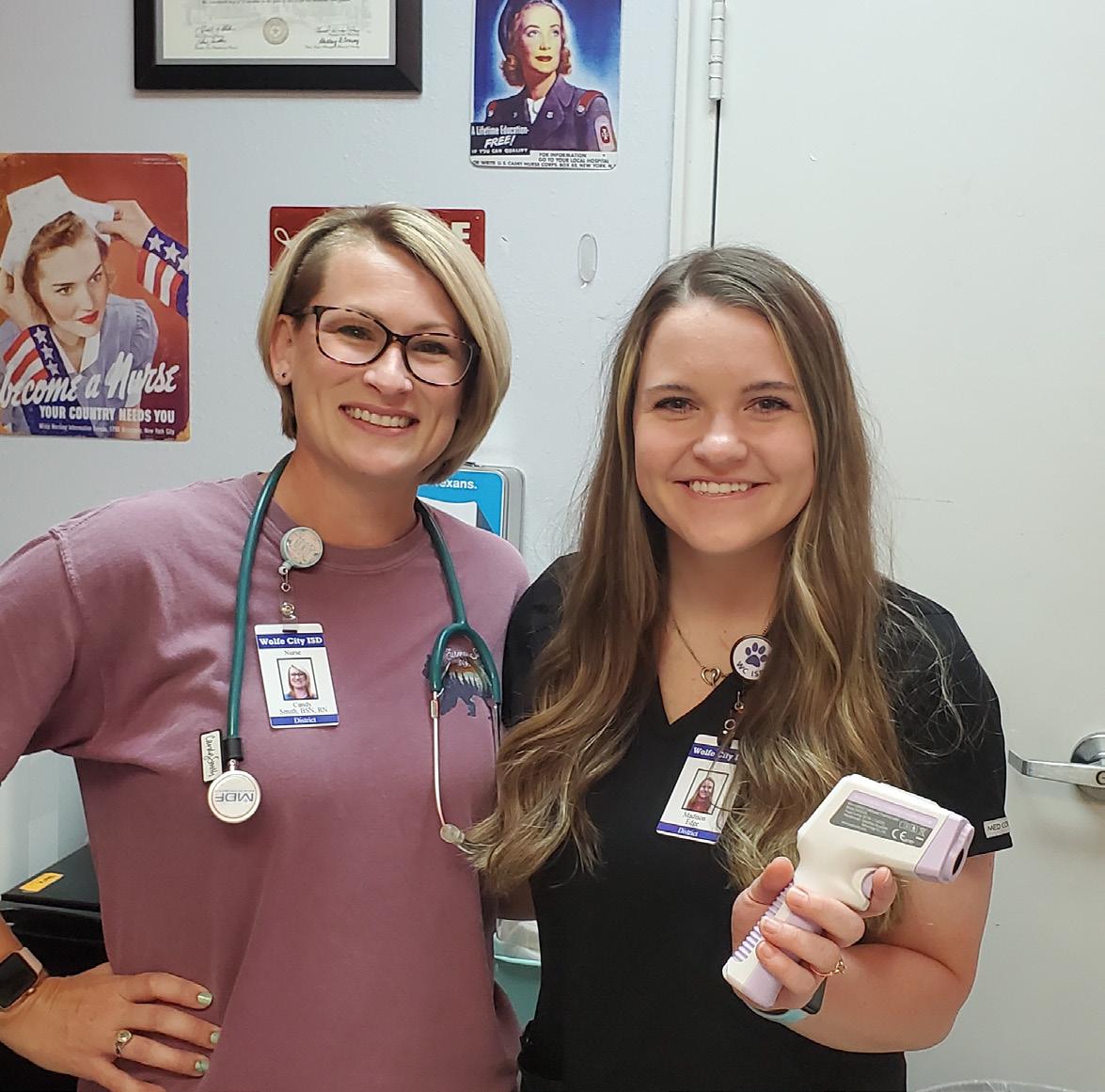
36
In addition to providing direct support with on-site nurses, Region 10 has developed a robust Nursing and School Health Services package to better serve the healthcare workers in our schools. The package includes multiple cohorts for school nurses, nurse leadership, new school nurses, nurse/health staff substitutes, and county school nurses. These cohorts are designed to educate and inform school nurses on a variety of topics including: school nursing practice, state and local health updates and resources, networking and collaboration, current health and nursing related topics. Additionally, Region 10 will provide nursing staff with summer professional development opportunities as well as on-site or virtual consultation, training, and technical support to meet the district’s needs.
To learn more about the Region 10 Nursing and School Health Services, contact Ginger Riggins.
ginger.riggins@region10.org

“I have been able to step in and provide health education and services to the students and staff in districts that haven’t had a nurse in 30 years!”
Data Discoveries
AUTHOR: DR. KAY SHURTLEFF Region 10 Research & Evaluation Analyst

WHAT DO WE REALLY KNOW ABOUT THE TEACHER SHORTAGE?
The teacher shortage is a hot topic of conversation these days, especially among educators and school administrators who are diligently developing innovative solutions to tackle this issue. We all know (or are!) teachers who are continually asked to cover classes, are overburdened with larger class sizes, and are unable to be away from the classroom for a professional development or personal day. We know librarians, nurses, administrators, and others who are pulled away from their “day jobs” to fill in for absent teachers. We look around and see that the teacher shortage is real and is affecting all of us. But what do we really know from researchers studying the problem? Is it as bad as we think? We decided to dig into the research to find out just how extensive the shortage is, why there’s a shortage, and how we might begin to address it. Here is what we learned.
WHERE ARE THE SHORTAGES?
According to the U.S. Department of Education (USDE, n.d.), the most severe
shortages in Texas for the 2021-2022 school year are in these areas:
¢ English as a Second Language (ESL) PreK-12
¢ Career and Technical Education (CTE) 7-12
¢ Special Education (SPED) PreK-12
¢ Mathematics 7-12
The USDE predicts those same shortages to exist next year (2022-2023), with additional shortages in Computer Science PreK-12, English Language Arts and Reading (ELAR) PreK-12, and Science 7-12. These shortages appear across the entire country, and additional shortages exist outside of Texas in Fine Arts, Early Childhood, and World Language classrooms.
While there doesn’t seem to be a particular demographic that is leaving their classrooms more than others, or a particular geographic area that is significantly harder hit (Harris, 2022; Rosenberg & Anderson, 2021), there are some takeaways we can consider from recent studies.
38
1. First, turnover is greater in high schools than in middle schools, and greater in middle schools than in elementary schools (American School District Panel, 2022).
2. Schools in less affluent areas are experiencing bigger shortages than those in higher income areas (Garcia & Weiss, 2019d; Horn et al., 2021).
3. Teacher turnover rates are increasing in all subject areas, but they seem to be the worst among foreign language teachers (Horn et al., 2021).
4. The two groups identified as the most likely to remain in their jobs are teachers who earned their credentials in a traditional university program (Guthery & Bailes, 2022; Horn et al., 2021) and those who teach at non-charter schools (Horn et al., 2021).
5. Most significantly, early career teachers (those who have been teaching less than three years) are at the greatest risk of leaving their teaching jobs (Rosenberg & Anderson, 2021; Wiggan & Watson-Vandiver, 2020).
6. Pandemic resignations differed by gender. This comes from one study involving six large urban school districts across the country (Rosenberg & Anderson, 2021). In the participating districts, during the 2019-2020 school year the rate of turnover for men decreased while the rate of turnover for women increased. In previous years, men resigned at a higher rate than women. It would be premature to generalize this phenomenon to the education sector as a whole, but it will be interesting to watch as more nationwide data becomes available.
39
HOW MANY EDUCATORS ARE LEAVING?
The Economic Policy Institute (EPI) predicts that by 2024, the number of teachers available and applying for positions will be only one third of the number of teachers needed to fill vacancies in classrooms (Harris, 2022). To compound the problem, fewer college students are choosing teaching as a career option. In 2019, just before the pandemic impacted education, the number of teacher certifications awarded nationwide was 20 percent lower than it had been just nine years earlier (Horn et al., 2021).
Our own Region 10 Teacher Job Network (TJN) data shows a 22 percent increase in the number of jobs posted this year, as compared to last year. We should point out that not all districts use this platform to advertise their vacancies, and some districts advertise only hard-to-fill positions on TJN. Regardless, TJN postings provide another indicator of the trend in the educational job market. In many districts, job vacancies posted on TJN are exponentially higher than they were during this time period one year ago. For example, one district increased from eight job postings in March of 2021 to 110 postings in March of 2022.
The most grim data we found comes from the National Education Association (NEA) survey, which reported that 55 percent of teachers are planning to leave the profession earlier than expected (Walker, 2022). The Rand Corporation provides a more conservative, but still troubling, estimate of 25 percent (Steiner et al., 2022).
had originally intended and within the next few years. Other shortage areas reported were administrators, curriculum specialists, and school psychologists (Harris, 2022).
WHY ARE TEACHERS LEAVING?
It is tempting to speculate that the Covid-19 pandemic is the cause of the teacher shortage, and certainly it has been a factor. However, the results of two major surveys (Schwartz & Diliberti, 2022; Walker, 2022) suggested that the pandemic likely magnified and accelerated an existing and ongoing problem.
Distilled into seven broad categories, here is what research is telling us about why teachers leave.
1. Low pay and high stress were commonly given as reasons teachers are leaving the profession (see Diliberti et al., 2021; Garcia & Weiss, 2019a; Steiner & Woo, 2021).
2. Stress is worse than low pay. As one study reported, 30 percent of teachers who left their professions before retirement age chose jobs outside of education with no health insurance or retirement benefits (Diliberti et al., 2022).
3. Teachers are more stressed than adults in other professions. In one study, 78 percent of teachers reported high levels of work-related stress, as compared to only 40 percent of the general adult population (Steiner & Woo, 2021).
We looked specifically at teacher shortages, but clearly there are shortages throughout the educational sector. One study (Schwartz & Diliberti, 2022) reported that the top four areas of need are substitute teachers, bus drivers, special education teachers, and paraprofessionals. The same study reported that 50 percent of the nation’s superintendents plan to leave their positions earlier than they
40
4. A separate study showed that teachers’ personal purchasing power has declined over the past decade (Horn et al., 2021) regardless of their salary rate.
5. Teachers need on-the-job support and professional development (Garcia & Weiss, 2019c; Garcia & Weiss, 2019d; Guthery & Bailes, 2022; Walker, 2022).
6. Concerns over Covid-19 caused teachers to leave because they felt underprepared and overworked. (Garcia & Weiss, 2019c; Garcia & Weiss, 2019d; Guthery & Bailes, 2022; Walker, 2022).
7. Another major reason for teacher attrition was a general lack of respect for teaching as a profession (Coffey et al., 2019; Garcia & Weiss, 2109a; Garcia & Weiss, 2019e; Lachlan et al., 2020; Rosenberg & Anderson, 2021; Steiner & Woo, 2021). Teachers expressed feeling unappreciated, misunderstood, and neglected.
WHAT CAN WE DO?
Despite the gloomy findings in recent research, there are inventive steps we can take to mitigate our current circumstances. In the short term, we can pay attention to teachers currently in the classroom. We are at the end of what is arguably the two most difficult school years teachers have experienced. We need to recognize and applaud their extraordinary efforts and encourage them to keep going. Beyond that, we can provide job embedded support in the form of time and resources for networking, planning, collaborating, and learning (Garcia & Weiss, 2019c; Guthery & Bailes, 2022).
In the long term, we can find inventive, creative ways to attract people to the education profession. One such model targets high school students and offers them dual credit in education-related courses with the long term goal of supporting their transition to a partner university’s college of education where they earn teaching credentials in a traditional way (Coffey et al., 2019; Lachlan et al., 2020). Other approaches, including our Region 10 Teacher Pipeline project, involve the alternative certification pathway to attract teachers (Garcia & Weiss, 2019d; Guthery & Bailes, 2022).
What is most clear is that swift intervention is critical. Education affects every sector of society, and so it will take an integrated effort on the part of multiple institutions and stakeholders to solve our shortage of teachers (Garcia & Weiss, 2020; Lachlan et al., 2020).
For a complete list of references, scan the QR code.
41
The Teacher Pipeline: Answering the Call for More Teachers
AUTHOR: DR. KAY SHURTLEFF Region 10 Research & Evaluation Analyst

IN EARLY OCTOBER 2021, Dr. Bud Nauyokas, Region 10 Director of Personnel and Certification Services, and Dr. Gordon Taylor, Region 10 Executive Director, met with Dr. Laura Isbell, Abbie Harper, and Rene Martinez from Texas A&M University - Commerce (TAMUC) to discuss ways to encourage more Hispanic students to attend college. When they scheduled that meeting, they had little idea they were about to launch a program to address the shortage of teachers in Texas! Their discussion led them to the need for speed and affordability in a college degree program, particularly for first generation college students. As their conversation progressed, they recognized the potential for a partnership that could not only encourage Hispanic and other minority students to attend college, but also redefine the path of
“TAMUC was looking at education in a different way. They were willing to let go of the traditional four-year model.”
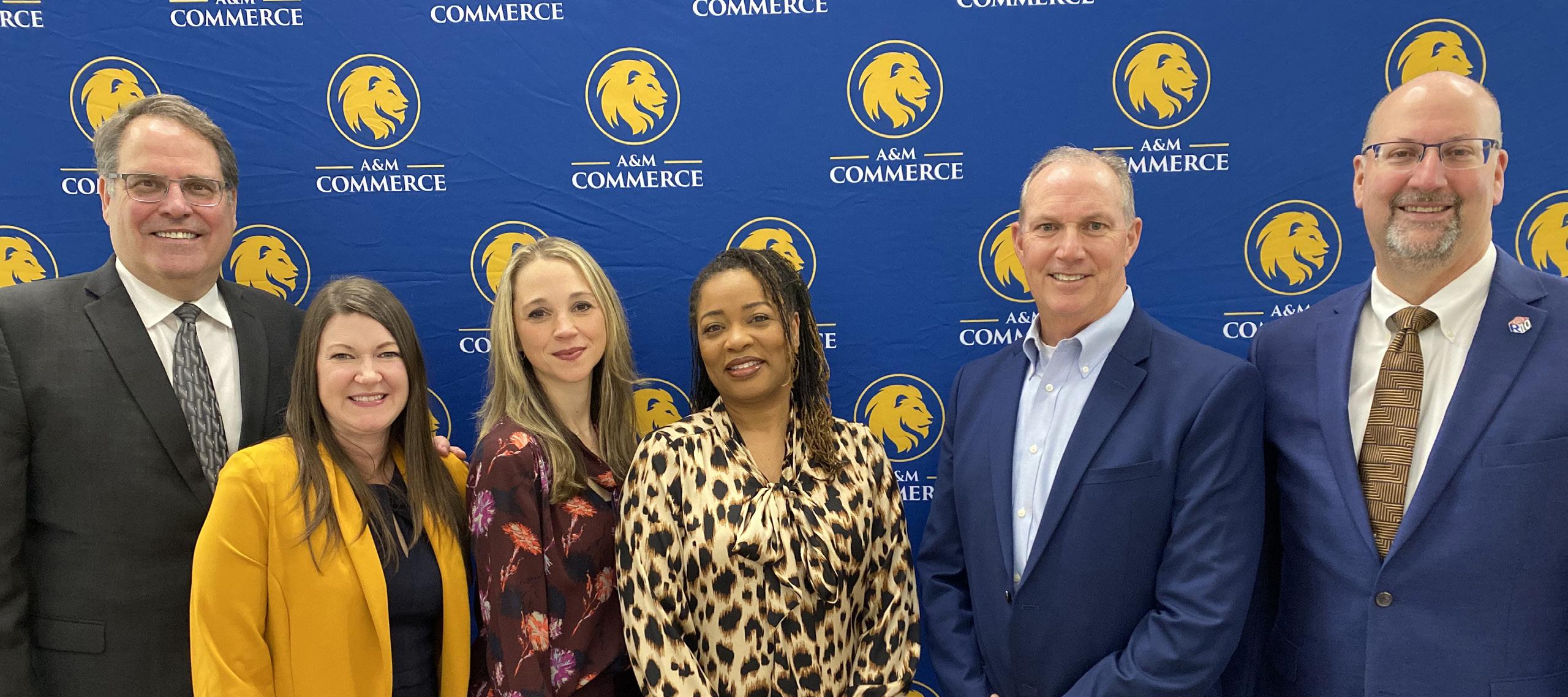
42
teacher certification for all students in this area. Dr. Nauyokas was excited to take on the project because, as he put it, “TAMUC was looking at education in a different way. They were willing to let go of the traditional four-year model.”
HERE’S HOW IT WORKS:
A high school graduate enrolls in the online bachelor of applied arts and sciences (BAAS) program at TAMUC. This degree can be completed in two years for under $10,000 - less if the student brings Dual Credit or AP test credit. Classes cost $750 per term, and there are 12 terms, each lasting seven weeks. Students take courses in core content areas, as well as courses in leadership, data based decision making, and organizational structure and change. As Dr. Nauyokas points out, “These are all skills needed in teaching, and sometimes traditional education programs don’t include all of those.”
Throughout their university coursework, students work with a TAMUC academic advisor who works in tandem with Region 10 staff to prepare them for working in a school. Once the two-year BAAS is completed, students enroll in the Region 10 Alternative Certification program, which costs around $5,500, where they will complete the required 300 hours of coursework and then be eligible to be hired in a school. At that point, the student is on contract with the district and getting paid as the teacher of record, but is still completing a practicum. Students have the huge benefit of a year-long mentor/field advisor to help them navigate the first year of teaching, provide feedback on their teaching, and give them support that early career teachers need but are not always provided. The first students to participate in this program began classes in January 2022.

Districts are excited about the possibilities and have already begun to explore ways they can help. One district is offering their graduating seniors who are accepted into the program positions as teacher aides or bus drivers. Those students will be able to earn income and enroll
in the Teacher Retirement System while they are completing their BAAS coursework. This gives them the chance to learn practical things such as the district protocols, systems, and the dayto-day operations of a school. Once they obtain their BAAS degree and complete the Region 10 Alternative Certification courses, the students will be hired as teachers in the district and complete their practicums. After that, they will be fully credentialed educators.
Another district is exploring subsidizing the cost of a student’s BAAS degree, provided the student will sign a three-year contract to teach in the district upon completion of the program. Other districts are using the program as a path for their current paraprofessionals, many of whom already have some transferable college hours, to become certified teachers.
The teacher shortage is a well-documented concern that calls for innovative, research backed solutions. (See "Data Discoveries" in this issue of ) We believe that the Teacher Pipeline Program answers that call by combining the benefits of a traditional bachelor of science degree from an accredited university with the hands-on, expedited pathway to alternative certification for teachers. We are excited to see where this venture takes us!
For more information about the Teacher Pipeline Program, contact Dr. Nauyokas.
bud.nauyokas@region10.org
43
To learn more about the Teacher Pipeline, scan the QR code.
Workingtogethertoachieveyourobjectives
LearninglosshasbecomeadefiningthemeofCovid.WhizzEducation'sresearchfoundthat almosthalfofstudentsintheUSexperiencedknowledgelossinmathematicsduringthefirst lockdown,withanaveragelossofeightmonths,itisevenwidernow.
Themorelearninglossgoesunchecked,thewideritbecomes,disadvantagingthosealready atthefringesofsociety,evenmore,wideningtheequitygap.Nowisthetimetoinvestintools thatwillrapidlyrecoverlostlearningandgeneratethegreatestcatch-up. Andyoucanuse yourESSERfundstodoso.







WhizzEducation’svirtualtutor, Math-Whizz: identifiestheabilityofeachofyourstudentsandtheareasinwhichtheyare strongestandweakest

createsapersonalizedlearningjourneyforeachstudenttomitigatelearningloss allowsteacherstosethomeworkandwholeclasslessonsinnotimeatall nomarkingisrequiredasMath-Whizzcontinuouslymarksstudents’performance easytousereportingshowshowstudents,classes,andschoolsareperformingso course-correctionimplementationsmaximizelearningoutcomes
Book your demo ofMath-Whizztoseehowitwillsolvelostlearningandrecoveryforyour studentstoday!



Scheduleyourappointmentvia


Sincerely,
KimGossett
USSchoolsDirector WhizzEducation

www.whizz.com/en-us/ info@whizz.com
A Certifiably Rewarding Experience
AUTHOR: MAX SMITH Region 10 Digital Marketing Specialist



CHRISTOPHER Cavenar’s classroom is a learning environment made for learners from all backgrounds. From a signlanguage interpreter helping facilitate discussions in his first period class, to a student with Down syndrome taking a specialized test in his fifth period class, to students teaching their fellow classmates, Cavenar has gone above and beyond to create environments where all of his students grow.
He has done all this as a new teacher at Plano Senior High School. With the help of his fellow teachers, his wife, and Region 10’s Alternative Certification Program, he has shattered expectations as a beginning teacher.
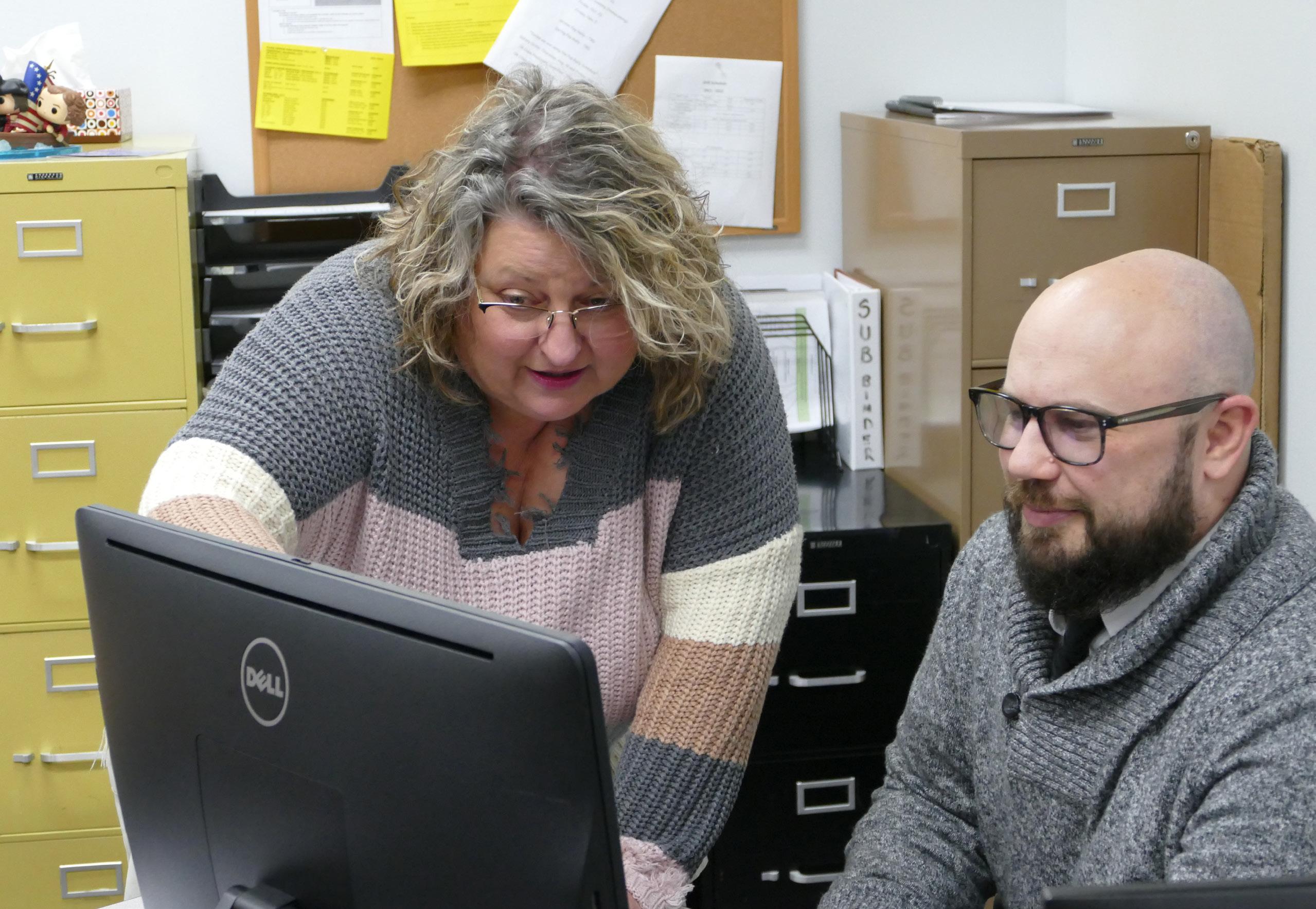
After working as a social worker for Child Protective Services (CPS), Cavenar was looking
to go into teaching so that he could combine his passion for working with kids with his passion for history and social studies. When he was looking into programs, his wife’s friend in Sherman ISD recommended he enroll in Region 10’s Alternative Certification program.
“There’s probably 100 different programs here, but the Region 10 Alternative Certification program came highly recommended. I didn't want to go back to college because I have a family, and I had to work. It was the most convenient way for me to get certified to teach,” Cavenar shared. “Everything in the program is straightforward. The biggest challenge is trying to work the Region 10 material into my job. Fortunately, a lot of it plays off of each other. As I'm learning through Region 10, I am able to implement the lessons here in the classroom.”
45
Cavenar has also received guidance from Dr. Patricia Williams, a Region 10 Consultant for the Alternative Certification program. Early in the year, she gave Cavenar valuable feedback that has improved his students’ ability to retain information.
“When Dr. Williams was here observing, she noticed that I was really good at talking ‘at’ my class, but there wasn’t a lot of engagement. She offered me a few pointers as it pertained to the lesson, and things we could go back and revisit,” Cavenar recalled. “I used those pointers during the following days, and my students were more engaged. We had a test shortly thereafter, and you can tell it really reflected in their test grades how much they retain just by making the lesson more conversational.”
When Cavenar first started teaching, he modeled much of his approach based on how his teachers taught him when he was a student by talking at his class versus with his students. Thanks to the feedback Dr. Williams provided, he has since changed his approach as he has grown in the program.
“How my teachers taught me doesn't work with kids anymore. My class is such a diverse group with different levels of learners, and that cookie cutter approach doesn't work anymore,” Cavenar explained. “I’ve found that I have become more individualized. When I'm looking at assignments, every single student crosses my mind as to how it is going to work for them.”
While Cavenar can’t individually teach every student due to time constraints, the Alternative Certification program taught him how to generalize his approach for his class by incorporating different methods, from hands-on activities to videos. Cavenar has also gone above and beyond to build individual connections with each student who enters his classroom. For him,
he wants each student to know that he truly cares about them.
“I always stand at the door to greet my students as they come into class in order to create a welcoming environment. I can tell immediately which kids are more standoffish or which kids I might not have anything in common with,” Cavenar shared. “I want to connect with them, so I try to learn their interests. I research a little bit and find something to talk to them about on a personal level. Every student in this room just wants to know that you have some kind of interest in them.”
For Cavenar, creating an inclusive environment where students of all backgrounds are able to learn is a challenge, but it’s one he welcomes with open arms.
“It's a lot of hard work, and it never really stops. I think about it when I should be going to bed at night, and I wake up thinking about it,” Cavenar explained. “I'm here two hours early every morning getting stuff ready for the day. It is the hardest thing I've ever done in my life, but it has also been the most rewarding. I've never had more fun doing something so hard.”
Cavenar’s dedication to his students during his first year of teaching has not gone unnoticed among his fellow teachers at Plano Senior High. As a result of his excellent work, he was named Plano Senior High School’s New Teacher of the Year.
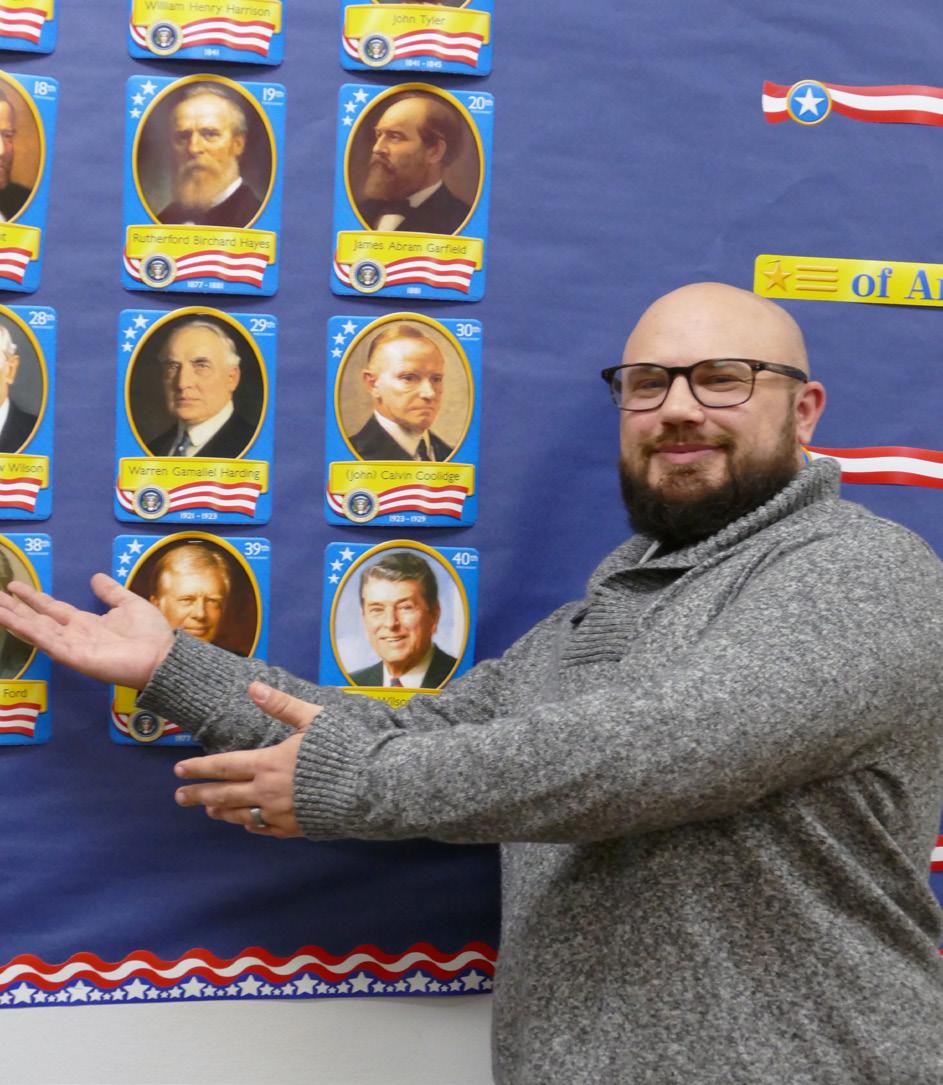
“I was so honored! I couldn't have been more pleased. It was like, ‘Wow, all that hard work paid off,'” Cavenar said. “The school’s administration and my fellow teachers have been really great and supportive throughout the whole year.”
Among those he credits for helping him during his first year, he thanks his wife, who is a teacher
46
for Plano ISD’s Beaty Early Childhood School. When Cavenar began teaching, she helped him better understand some of the tools educators use in the classroom.
“She's a very good teacher, and she’s taught for years. She's the one who sat me down and showed me how to use Google Classroom and the technology that I would be using,” Cavenar said. “I would show her my lesson plans for feedback, and she was able to help me with building relationships and managing my time. She also pointed out tools and strategies that might be more effective in the classroom.”
According to Lindsay Scott, his Team Lead for US History, Cavenar went above and beyond what was expected from him as a beginning teacher.
“Cavenar walked into his first year teaching during a firestorm of a year, but he is the type of person who walks into the fire and calms the storm,” Scott shared. “He is truly a gift to education and so needed during this time, by his students and by his peers. As a beginning
"My class is such a diverse group with different levels of learners...When I'm looking at assignments, every single student crosses my mind as to how it is going to work for them.”
teacher, Cavenar is supposed to be full of questions and mistakes. However, every day he motivates his students as their facilitator in learning while inspiring our team of teachers as he takes on one of the most difficult roles on campus with dignity and grace.”
ALL ROADS LEAD TO REWARDS... ALL ROADS LEAD TO REWARDS...
 Program Manager - Region
Program Manager - Region

TIPS Purchasing Cooperative is an educational agency that offers national contract purchasing solutions to save your school district time and money in the procurement process. TIPS Rewards Dollars are based on all purchases processed through TIPS.

MAP YOUR ROUTE TO REWARDS TODAY!
$$$ $$$ $$$ $$$ $$$ $$$ $$$ $$$ MAINTENANCE Security ENERGY Technology Equipment CONSTRUCTION
TIPS
10 whitley.allen@tips-usa.com 903-277-5531
Whitley Allen
INTENTIONAL LEADERSHIP PODCAST – NOW ON AIR!
AUTHOR: NIQUITA SPEARMAN NLS Marketing Founder
It’s time to Motivate, Inspire, Transform. Head towards the future. Reach for the stars.
The Genesis of change begins from within. When you learn to lead, everyone wins. It’s Intentional Leadership.
These are the lyrics of the Intentional Leadership Podcast theme song that illustrates intentional leaders at Academy of Dallas and Bexar County Academy Public Charter Schools on any given day. In March of 2022, through the creativity of NLS Marketing Founder, Niquita Spearman and Public Charter School Superintendent Dr. Ross F. Williams Jr., the development of this interactive digital format offers authentic and thought-provoking point of discussions (hot topics) through self-reflection that motivates, inspires, and transforms any individual mindsets for impactful change.
The Intentional Leadership Podcast was created out of a vision to provide a platform for candid conversations about purposeful leadership in education and continues to evolve into deeper discussions surrounding community, culture, and climate. As the podcast host, Dr. Williams, also known as “Dr. Ross,” engages and challenges



guests in organic conversations about intentional decision-making as leaders and its impact in the community. Guests range from policy makers, business and community leaders, and entrepreneurs, to middle school scholars and education advocates.
In a most recent airing of the Intentional Leadership Podcast, Dr. Nadia Lopez spoke to the necessities in educational leadership and her work to improve education disparities by providing a master class on intentional leadership. Dr. Lopez is an award-winning educator who became a viral sensation after the popular blog Humans of New York featured her as one of the most influential people of this life. Disrupting the school-to-prison pipeline, she has been named LinkedIn’s 2019 Top 10 Voices in Education and received the Black Girls Rock award – alongside Michelle Obama in 2015. She is a bestselling author of The Bridge to Brilliance
Photos: NLS Marketing & Bold Entity 48
– How One Woman and One Community Are Inspiring the World and her Ted Talk on the "Education Revolution" has garnered more than a million views.
During a visit to Dallas as the keynote speaker of the 2021 Texas Public Charter Schools Association Conference, Dr. Lopez joined her colleague and friend, Dr. Ross, for the first Intentional Leadership Podcast session at Academy of Dallas Public Charter School. When Dr. Ross asked Dr. Lopez her definition of a “leader” she shared:
“For me, a leader is someone who does not require a title to do what is right. A leader is someone who is willing to stand up and speak out even when it makes others uncomfortable. A leader is audacious and very much intentional about what they do. But they are also understanding of the people they serve, and that is often missing in leadership. We get into a position, and we fail to understand that there was a purpose before you got the power and the power was never supposed to drive your leadership, it is supposed to be your purpose.”
The podcast's authentic conversations open up the challenges of education today – especially as it relates to minorities, practical solutions to these challenges, and the stories of those who are making a difference. Dr. Ross shared the
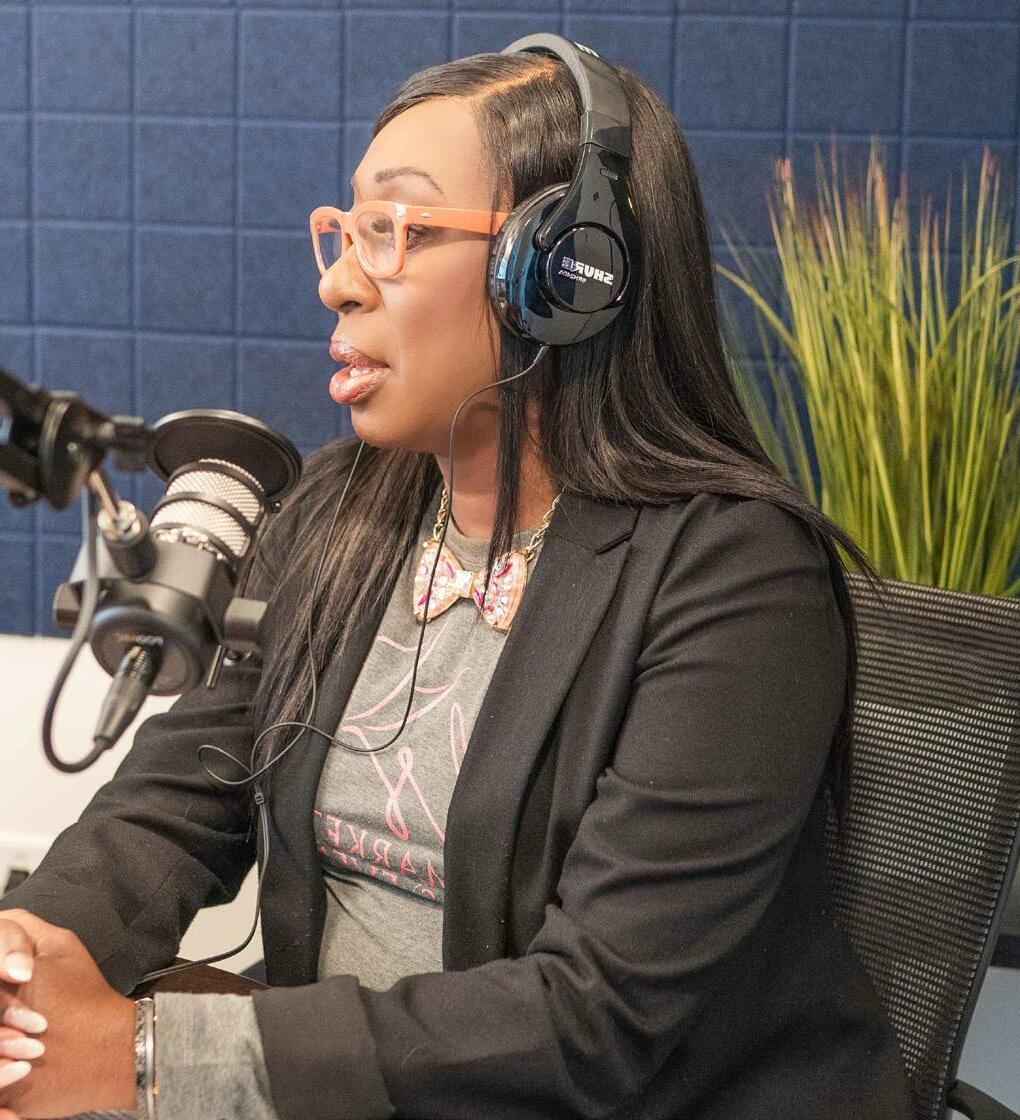
“why” for an Intentional Leadership Podcast:
“Understanding leadership is not about a title or position. It is about being intentional in developing culture and climate in any organization - intentional about meeting the needs and supporting those in leadership to be successful and giving students the tools and resources to achieve, so students can be successful in life.”
While education continues to be a challenge across the country due to pandemic teaching, there have also been difficulties in socialization within communities.
“We created the podcast from a need to communicate out of a pandemic the importance of providing a platform that supports professional learning for leaders and educators who are intentionally focused on making sure students are learning and that their organizations are successful,” Spearman explained.
The Intentional Leadership Podcast airs weekly on all major podcast platforms or wherever you get your podcasts, and is available in both video and audio formats. The Intentional Leadership Podcast is powered by Academy of Dallas and Bexar County Academy Public Charter Schools.

49


A Cut Above
 AUTHOR: COOPER WELCH Community ISD Communications Supervisor
AUTHOR: COOPER WELCH Community ISD Communications Supervisor
IN THE FIRST MONTH of her tenure as Community ISD Superintendent, Dr. Tonya Knowlton visited the BLUE Brave Nation Nail Salon and Spa, the cosmetology department at Community High School’s Career and Technical Education (CTE) Center.
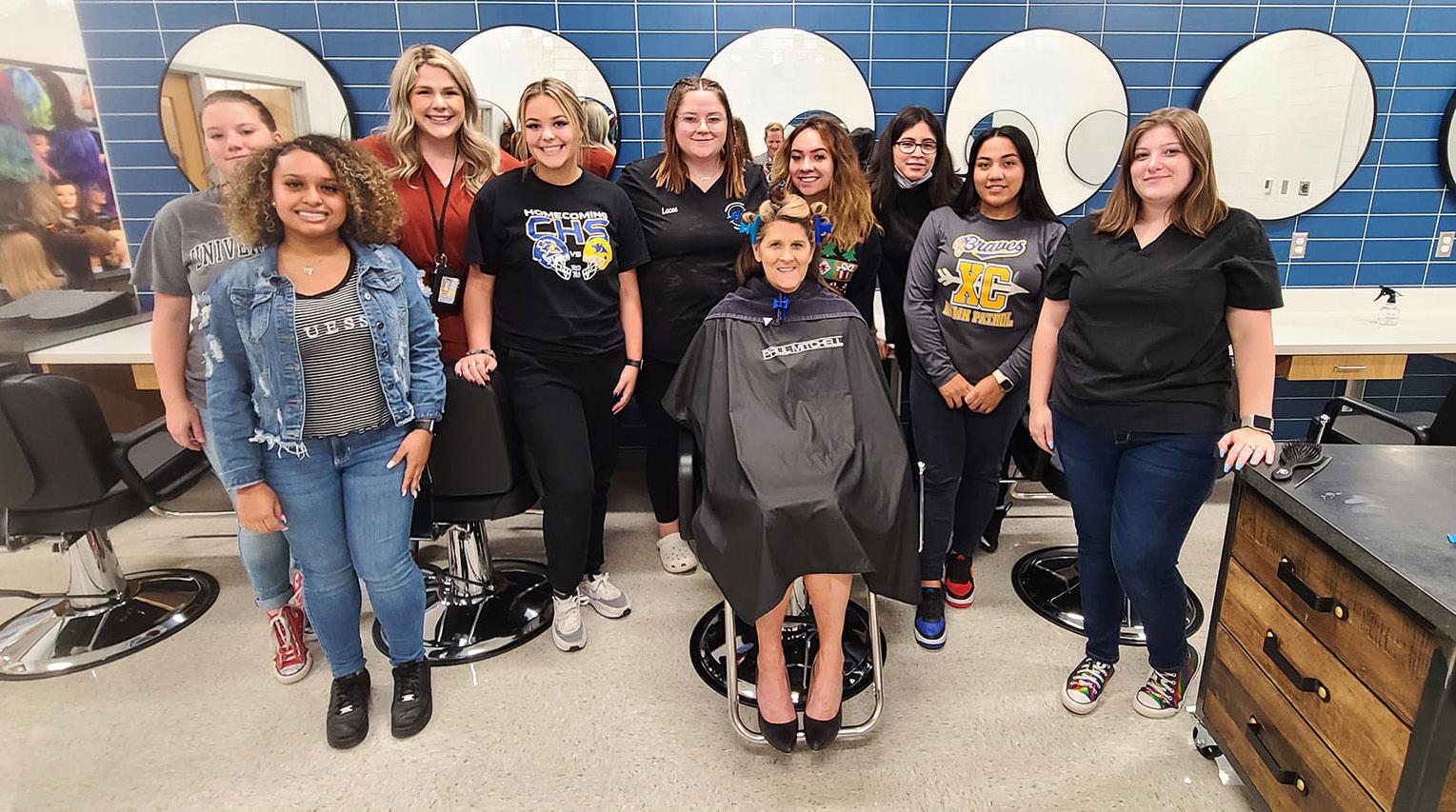
“Personally, when Dr. Knowlton asked to come and get a service at our salon, I was super excited! It’s not everyday that an important leader in the district trusts high school students with their hair,” McKenna Smith, Dual Credit Cosmetology Instructor at Community High school, shared. “I was humbled by her kindness and support of our program and excited to be able to show her what the Blue Brave Nation Nail Salon and Spa is all about.”
While on her visit, Dr. Knowlton learned about the services that the salon offers to the public - at only the cost of the supplies. Intrigued, Dr. Knowlton booked an appointment with the salon for a cut-and-color.
“One of our senior stylists, Lacee Harwood, was the student in charge of coloring and
cutting Dr. Knowlton’s hair. She said she had a lot of fun doing her hair and was honored that she was able to provide the service,” Smith said. “Opportunities like this are what help our students become industry ready. Lacee now has her Texas Cosmetology Operator License and is ready to step into the salon with some amazing experiences under her belt!”
While there, Dr. Knowlton also met with other cosmetology students and discussed their experiences in the program. After Dr. Knowlton’s first visit, the BLUE Brave Nation Nail Salon and Spa received a significant boost in customers, including additional visits from Dr. Knowlton and members of her senior staff.
“Business has been great this year since Dr. Knowlton’s visit! Since it was posted on social media, we were able to reach a larger audience than normal who didn’t know about us,” Smith explained. “We were able to grow our clientele and give our students more opportunities for hands-on learning.”
51
Photo: Community ISD
Taking Teaching Skills to the Next Level
WITH TEXAS INSTRUCTIONAL LEADERSHIP
AUTHOR: ANDY STAUFFER
Region 10 Communications Program Coordinator
DO THE WORDS “data driven instruction” – or the acronym “DDI” - send shivers down your spine?
Donna McAda serves as the Executive Director for Accountability and Assessment at Mesquite ISD, and with a title like that, she often gets pegged as someone who loves numbers. But for McAda, it’s not simply about the numbers.
“People will say to me, ‘Oh, you must love numbers.’ No, I don't love numbers. I love the questions that numbers bring to the table. Those questions usually have to do with what do our teachers need to be better in certain area … and DDI is a big piece of that because our teachers want to be effective; they want to do what they need to do for their students.”
Jaclyn Byrom, Region 10 Administrative Services Program Coordinator, connects the efficacy of DDI with interruptions in learning that students suffered during the pandemic.
“Right now, campuses are seeing huge benefits for students. Principals are able to better support their teachers in addressing the gaps and learning loss that students experienced due to COVID,” Byrom shared.
Byrom is part of the Texas Instructional Leadership (TIL) team at Region 10. TIL is a service offered by the ESCs that works to
build teachers’ skills through professional development, implementation support, and coaching so that they can continuously improve instruction for all students.
TIL training is built around intensive face-toface professional development that builds facility with five essential tools: observation and feedback, data-driven instruction, schoolwide culture routines, lesson alignment, and formative assessment.
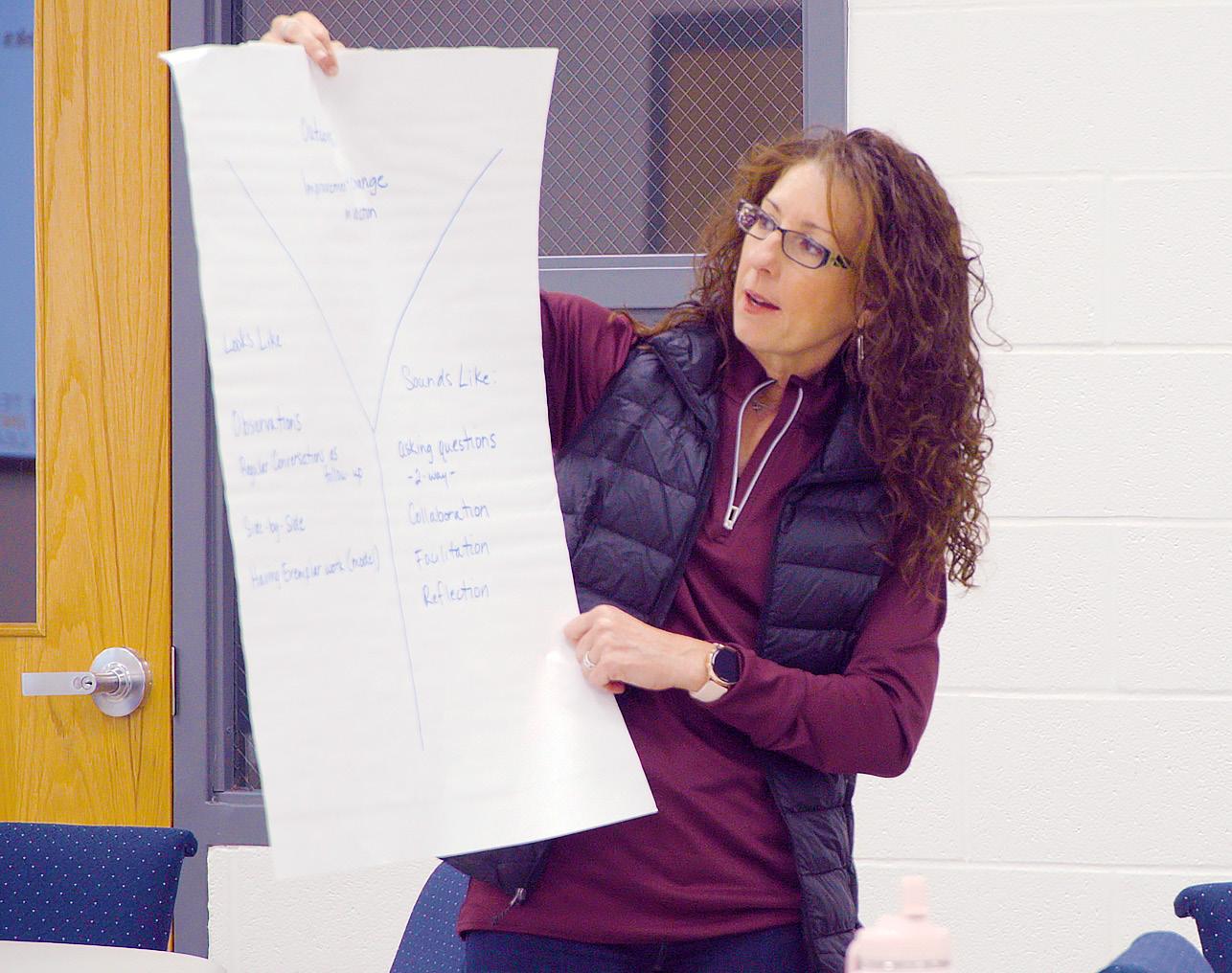
IMPACT:
This year, 95% of principals Region 10 coached mastered the identified action steps.
REACH:
Region 10 coached 60 principal supervisors/principals. This is the largest number of TIL cohort members of any ESC in the state.
SATISFACTION:
In a mid-year survey conducted, 87% of educators coached by Region 10 would strongly recommend the TIL program to a colleague.
15 districts • 105 campuses • 79k students
52
At Region 10, the TIL team stress-tests their coaching through frequent role-playing exercises.
“We support leaders by training them and coaching them. In training, they see a model of the skill in action, practice how to do it, and then create a plan for implementation,” says Dr. Matt Pierson, TIL Lead at the ESC. “In coaching, we work side-by-side with them to help them grow their ability to lead systems or develop others through coaching. It’s a direct follow-up support to what they learned in training.”
Teachers at Red Oak ISD have worked with the Region 10 TIL team, and are seeing tangible benefits.
“Our students are getting clearer, specific instruction from our teachers through learning objectives,” Lynn Dockery, Red Oak ISD Director of Secondary Curriculum Instruction, explained. “Teachers understand what they're teaching, and they're able to dissect the standards that they must teach the students. Then, they're able to scaffold that instructional piece from day-to-day.
In turn, they help students to understand and put together those pieces so they grasp concepts better. That’s the benefit for our students.”
At Vivian Field Middle School in CarrolltonFarmers Branch ISD, faculty have embraced the payoff of the rigorous discipline demanded by TIL. Greg Thrasher, who teaches Eighth Grade Math, affirms, “The bottom line is what are we going to do to facilitate the best things for our kids? Our teachers have that in mind. They know that we're going to meet the needs of the kids, and this process will help you. It'll give you the tools that are necessary to see your students grow.”
To learn more about the TIL program available through Region 10, scan the QR code.

Give Teachers Time to Do More!
Supercharge the data insights of your school or district with Istation’s enhanced educator platform. Co-created with teachers, the innovative hub offers a sleek look, more personalization than ever before!
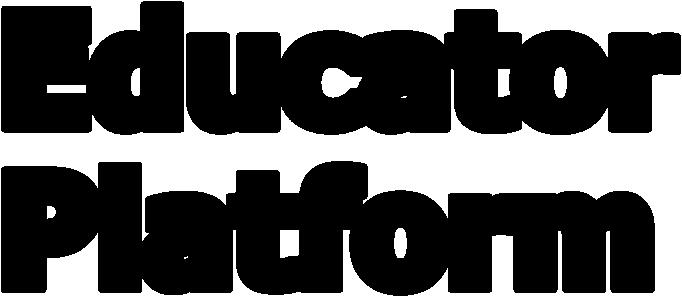
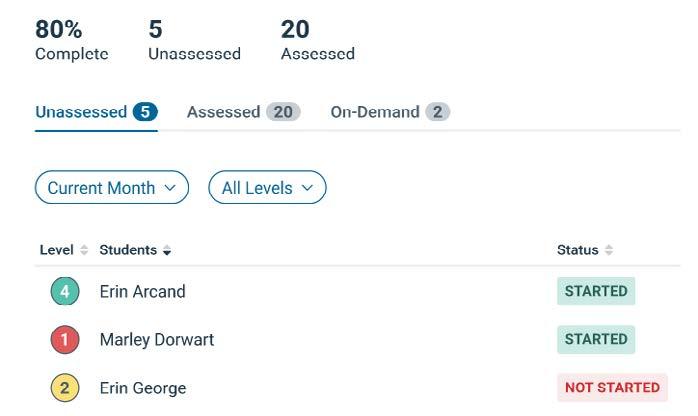
Help teachers easily translate data into action for powerful student growth!

• weekly notifications about student activity and recommended next steps;

• key alerts with important reminders;
• personalized dashboards with data visualization; plus
• teacher tutorials, resources, support, and much more!



Assessments and Instruction for Reading, Math, and Spanish Literacy

All New All New info.istation.com/new
We believe we have a responsibility to leave the world better than we found it. All our projects are designed to have a positive and enduring environmental, economic and social impact.

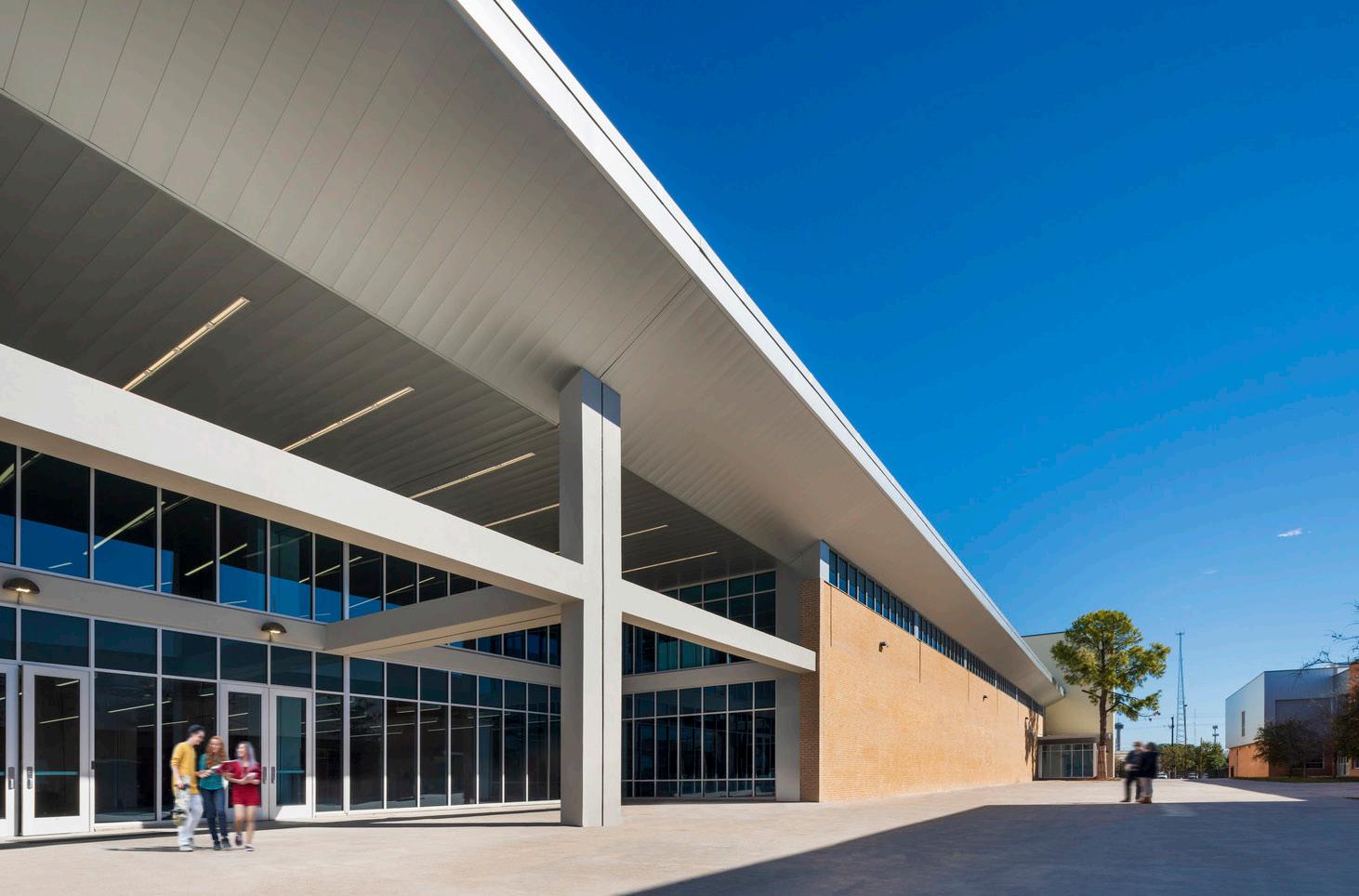
We’re committed to changing lives by design. Let’s start the discussion today.

 CARROLL H.S. TURF FIELD REPLACEMENTS
Carrollton-Farmers Branch ISD
Carroll ISD
CARROLL H.S. TURF FIELD REPLACEMENTS
Carrollton-Farmers Branch ISD
Carroll ISD
ARCHITECTURE INTERIOR DESIGN LANDSCAPE ARCHITECTURE PLANNING DALLAS SAN ANTONIO IRVINE SACRAMENTO SAN DIEGO SAN JOSE LPADesignStudios.com LPA Dallas Studio 1801 N. Lamar Street, Suite 150 Dallas, TX 75202 469.899.5110
Carrollton-Farmers Branch ISD
SHEFFIELD ELEMENTARY
SMITH HIGH SCHOOL
Lanier High School - San Antonio ISD
FALL ‘22
FALL ‘22
Find Out More











































































































 Program Manager - Region
Program Manager - Region























 CARROLL H.S. TURF FIELD REPLACEMENTS
Carrollton-Farmers Branch ISD
Carroll ISD
CARROLL H.S. TURF FIELD REPLACEMENTS
Carrollton-Farmers Branch ISD
Carroll ISD















